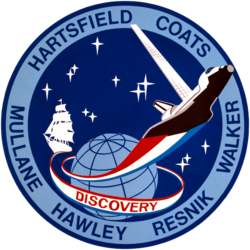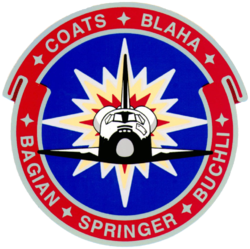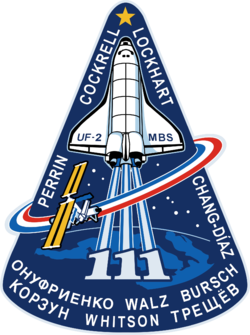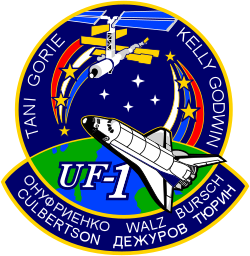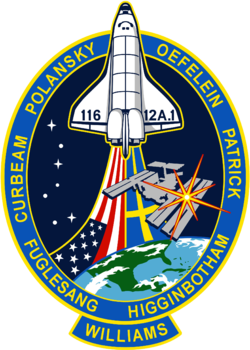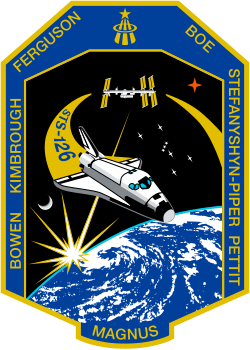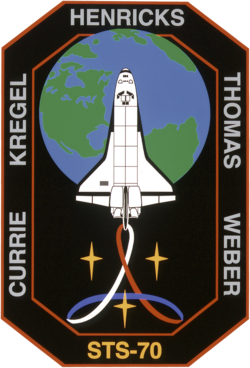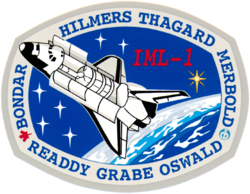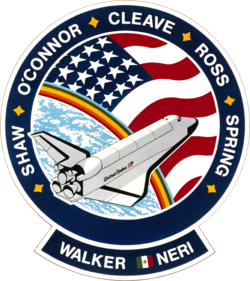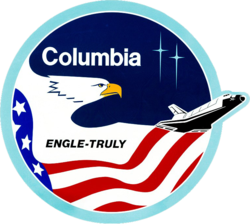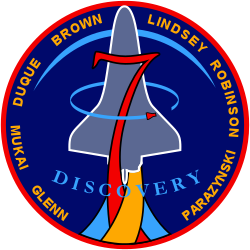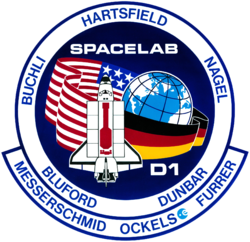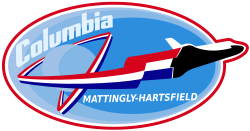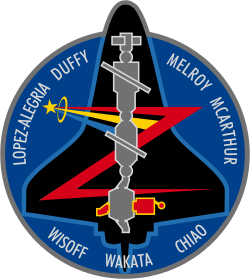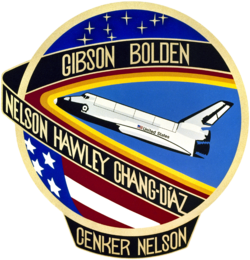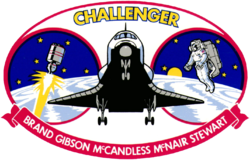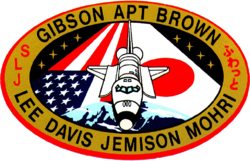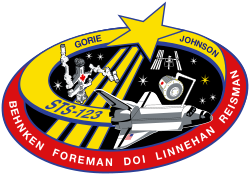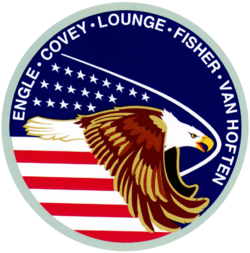Liste der Space-Shuttle-Missionen
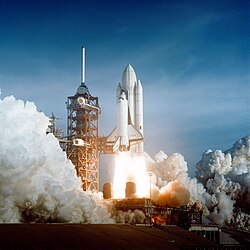

Die folgende Liste der Space-Shuttle-Missionen führt die Starts des US-amerikanischen Space-Shuttle-Programms chronologisch auf. Alle Space-Shuttle-Starts erfolgten bemannt und wurden von der NASA durchgeführt. Alle Starts erfolgten vom Kennedy Space Center (KSC) von den Startanlagen LC-39A und LC-39B. Ab 2007 wurde nur noch LC-39A benutzt.
Benennung und Nummerierung
Alle Missionen begannen mit dem Kürzel STS, das für „Space Transportation System“ stand. Ursprünglich bezeichnete die folgende Nummer einfach die Nummer des Starts, z. B. STS-9. Beginnend mit dem fiskalischen Jahr 1984 wurde eine alternative Flugnummerierung bestehend aus zwei Ziffern und einem Buchstaben eingeführt.
Die erste Ziffer zählte das fiskalische Jahr des Shuttle-Programms. Das im Oktober 1983 beginnende fiskalische Jahr 1984 war das vierte des Programms, dementsprechend bekamen alle für diesen Zeitraum geplanten Flüge die „4“ vorangestellt. Die zweite Ziffer der Flugnummer kennzeichnete den Startplatz: 1 für das Kennedy Space Center in Florida und 2 für die Vandenberg Air Force Base in Kalifornien. Vandenberg wurde aber niemals benutzt. Zuvor hatte man Flugnummern für beide Startplätze lediglich durch den zusätzlich vorangestellten Buchstaben „V“ für Vandenberg unterschieden, also etwa STS-V4.
Der abschließende Buchstabe gab die vorgesehene Startreihenfolge wieder. Also war beispielsweise 51-G als siebter Flug des fünften fiskalischen Programmjahres vom Kennedy Space Center aus geplant.
STS-10 war bereits abgesagt worden, als das neue System eingeführt wurde, und den Start von STS-9 hatte man zu der Zeit vom fiskalischen Jahr 1983 auf das nachfolgende verschoben. Und tatsächlich gibt es NASA-Dokumente, in denen STS-9 als 41-A ausgewiesen wird. Erst mit STS-11 hatte sich das neue System jedoch durchsetzen können. Dieser Flug fand als 41-B statt.
Die erste Ziffer der Flugnummer ist also nicht einfach die letzte Ziffer des fiskalischen Jahres, was oftmals fälschlicherweise behauptet wird. Diese Übereinstimmung gilt nur für die Jahre von 1984 bis 1989. Das fiskalische Jahr 1990 hätte unter Beibehaltung dieses Systems mit dem Flug 101-A für das KSC bzw. dem Flug 102-A für Vandenberg begonnen.
Nach der Challenger-Katastrophe (STS-51-L) kehrte man wieder zur fortlaufenden Durchnummerierung zurück, wobei die Nummer 17 Monate vor dem Start „eingefroren“ und nicht mehr geändert wird.
Besondere Umstände erforderten jedoch die Vergabe von Flugnummern außerhalb der Reihe. Als 2001 diskutiert wurde, den Satelliten DSP-22 im Jahre 2003 mit der Columbia zu starten, erhielt dieser Flug zu Planungszwecken die Kennung STS-999 als Platzhalter im Manifest. Jahre zuvor wurde STS-250 vorbereitet. Beim Versagen des russischen Servicemoduls für die ISS hätte STS-250 das Interim Control Module, oder ICM, als Ersatz zur Station gebracht.
Nach der Columbia-Katastrophe (2003) war STS-300 eine mögliche Rettungsmission für die Discovery (STS-114, 2005), die von der Atlantis ausgeführt werden sollte, falls die Discovery beschädigt worden wäre und nicht mehr zur Erde hätte zurückkehren können. Auch während der Mission STS-121 der Discovery (2006) behielt Atlantis die Rolle als Rettungsshuttle und die damit verbundene Missionsnummer STS-300.
Für die Mission der Atlantis (STS-115) stand die Discovery für eine eventuelle Rettungsmission zur Verfügung. Diese Rettungsmission trug die Nummer STS-301.
Ab Mission STS-116 (Discovery) wurde für die Rettungsmissionen ein neues Nummernsystem verwendet. Die Atlantis diente dann als Rettungsshuttle und erhielt die Nummer STS-317. Diese neue Nummerierungsmethode war insofern sinnvoller, als die Atlantis zu diesem Zeitpunkt auf ihren zugewiesenen Flug STS-117 vorbereitet wurde. Im Falle einer Rettungsmission hätte sich damit nur die erste Ziffer von 1 auf 3 geändert.
Flugliste
Absolvierte Flüge
| Nr. | Startdatum (UTC) | Bezeichnung | Raumfähre | Start- platz | Landeplatz | Anmerkung |
|---|---|---|---|---|---|---|
| 1 | 12. April 1981 | STS-1 | Columbia | LC-39A | Edwards AFB | Erster Raumflug eines wiederverwendbaren Raumfahrzeugs |
| 2 | 12. November 1981 | STS-2 | Columbia | LC-39A | Edwards AFB | Shuttle-Test-Mission, Canadarm erfolgreich getestet |
| 3 | 22. März 1982 | STS-3 | Columbia | LC-39A | White Sands | Shuttle-Test-Mission, einzige Landung eines Shuttles in White Sands |
| 4 | 27. Juni 1982 | STS-4 | Columbia | LC-39A | Edwards AFB | Shuttle-Test-Mission, geheime Nutzlast des DoD |
| 5 | 11. November 1982 | STS-5 | Columbia | LC-39A | Edwards AFB | Mehrere Nachrichtensatelliten ANIK C-3 und SBS-C ausgesetzt |
| 6 | 4. April 1983 | STS-6 | Challenger | LC-39A | Edwards AFB | TDRS-1 ausgesetzt, erster Außenbordeinsatz bei einer Shuttle-Mission durch Story Musgrave |
| 7 | 18. Juni 1983 | STS-7 | Challenger | LC-39A | Edwards AFB | Kommunikationssatelliten ANIK C-2 und PALABA B-1 ausgesetzt, Sally Ride ist erste Amerikanerin im All |
| 8 | 30. August 1983 | STS-8 | Challenger | LC-39A | Edwards AFB | Kommunikationssatellit INSAT-1B ausgesetzt |
| 9 | 28. November 1983 | STS-9 | Columbia | LC-39A | Edwards AFB | erste Spacelab-Mission, erstmals sechs Astronauten im Shuttle, erstmals ein Nichtamerikaner an Bord eines Space Shuttle |
| 10 | 3. Februar 1984 | STS-41-B | Challenger | LC-39A | KSC | Kommunikationssatelliten WESTAR-VI und PALABA-B2 ausgesetzt, erfolgreicher MMU-Test |
| 11 | 6. April 1984 | STS-41-C | Challenger | LC-39A | Edwards AFB | LDEF ausgesetzt, Bergung von Solar Maximum Mission |
| 12 | 30. August 1984 | STS-41-D | Discovery | LC-39A | Edwards AFB | Kommunikationssatelliten SBS-D, TELSTAR-3C und IVSYNCOM IV-2 ausgesetzt |
| 13 | 5. Oktober 1984 | STS-41-G | Challenger | LC-39A | KSC | Earth Radiation Budget Satellite ausgesetzt |
| 14 | 8. November 1984 | STS-51-A | Discovery | LC-39A | Edwards AFB | Kommunikationssatelliten TELESAT-H und SYNCOM IV-1 ausgesetzt, Rückholung von PALABA-B2 und WESTAR-IV |
| 15 | 25. Januar 1985 | STS-51-C | Discovery | LC-39A | Edwards AFB | Magnum ausgesetzt |
| 16 | 12. April 1985 | STS-51-D | Discovery | LC-39A | Edwards AFB | Kommunikationssatellit TELESAT-1 ausgesetzt, Start von SYNCOM-IV3 scheitert an fehlerhaftem Zündschalter |
| 17 | 29. April 1985 | STS-51-B | Challenger | LC-39A | Edwards AFB | Spacelab-Mission, GLOMR nicht ausgesetzt |
| 18 | 17. Juni 1985 | STS-51-G | Discovery | LC-39A | Edwards AFB | Kommunikationssatelliten ARABSAT-A, MORELOS-A und TELSTAR-3D ausgesetzt |
| 19 | 29. Juli 1985 | STS-51-F | Challenger | LC-39A | Edwards AFB | Spacelab-Mission. Einziger Abort-to-Orbit mit nur zwei Triebwerken und einziger Abbruch nach dem Start. Die Mission konnte trotzdem durchgeführt werden. |
| 20 | 27. August 1985 | STS-51-I | Discovery | LC-39A | Edwards AFB | Kommunikationssatelliten ASC-1, AUSSAT-1 und SYNCOM-IV4 ausgesetzt |
| 21 | 3. Oktober 1985 | STS-51-J | Atlantis | LC-39A | Edwards AFB | Zwei DSCS-Satelliten ausgesetzt |
| 22 | 30. Oktober 1985 | STS-61-A | Challenger | LC-39A | Edwards AFB | D-1-Spacelab-Mission, GLOMR ausgesetzt |
| 23 | 27. November 1985 | STS-61-B | Atlantis | LC-39A | Edwards AFB | Kommunikationssatelliten MORELOS-B, AUSSAT-2 und SATCOM KU-2 ausgesetzt |
| 24 | 12. Januar 1986 | STS-61-C | Columbia | LC-39A | Edwards AFB | Kommunikationssatellit SATCOM KU-1 ausgesetzt |
| 25 | 28. Januar 1986 | STS-51-L | Challenger | LC-39B | – | Start des 2. TDRS geplant, zu niedrige Temperatur zerstört Dichtungsring eines der SRBs, |
| 26 | 29. September 1988 | STS-26 | Discovery | LC-39B | Edwards AFB | TDRS-3 ausgesetzt |
| 27 | 2. Dezember 1988 | STS-27 | Atlantis | LC-39B | Edwards AFB | Spionagesatellit Lacrosse 1 ausgesetzt |
| 28 | 13. März 1989 | STS-29 | Discovery | LC-39B | Edwards AFB | TDRS-4 ausgesetzt, Versuche mit Hühnerembryos |
| 29 | 4. Mai 1989 | STS-30 | Atlantis | LC-39B | Edwards AFB | Venussonde Magellan ausgesetzt |
| 30 | 8. August 1989 | STS-28 | Columbia | LC-39B | Edwards AFB | SDS-2 ausgesetzt |
| 31 | 18. Oktober 1989 | STS-34 | Atlantis | LC-39B | Edwards AFB | Jupitersonde Galileo ausgesetzt, erste Fotos von Blitzen, die die Gewitterwolken nach oben verlassen |
| 32 | 23. November 1989 | STS-33 | Discovery | LC-39B | Edwards AFB | Magnum-Satellit ausgesetzt |
| 33 | 9. Januar 1990 | STS-32 | Columbia | LC-39A | Edwards AFB | SYNCOM IV-5 ausgesetzt, |
| 34 | 28. Februar 1990 | STS-36 | Atlantis | LC-39A | Edwards AFB | KH-11 Kennan ausgesetzt |
| 35 | 24. April 1990 | STS-31 | Discovery | LC-39B | Edwards AFB | Hubble-Weltraumteleskop ausgesetzt |
| 36 | 6. Oktober 1990 | STS-41 | Discovery | LC-39B | Edwards AFB | Sonnensonde Ulysses ausgesetzt |
| 37 | 15. November 1990 | STS-38 | Atlantis | LC-39A | KSC | Magnum-Satellit ausgesetzt |
| 38 | 2. Dezember 1990 | STS-35 | Columbia | LC-39B | Edwards AFB | ASTRO-1 Observatorium genutzt |
| 39 | 5. April 1991 | STS-37 | Atlantis | LC-39B | Edwards AFB | Compton Gamma Ray Observatory ausgesetzt |
| 40 | 28. April 1991 | STS-39 | Discovery | LC-39A | KSC | Mission für das Department of Defense (DoD) |
| 41 | 5. Juni 1991 | STS-40 | Columbia | LC-39B | Edwards AFB | Spacelab-Mission |
| 42 | 2. August 1991 | STS-43 | Atlantis | LC-39A | KSC | TDRS ausgesetzt |
| 43 | 12. September 1991 | STS-48 | Discovery | LC-39A | Edwards AFB | Upper Atmosphere Research Satellite ausgesetzt |
| 44 | 24. November 1991 | STS-44 | Atlantis | LC-39B | Edwards AFB | Defense Support Program Satellit ausgesetzt |
| 45 | 22. Januar 1992 | STS-42 | Discovery | LC-39A | Edwards AFB | International Microgravity Laboratory-1 (IML-1) |
| 46 | 24. März 1992 | STS-45 | Atlantis | LC-39A | KSC | Atmospheric Laboratory for Applications and Science (ATLAS-1) |
| 47 | 7. Mai 1992 | STS-49 | Endeavour | LC-39B | Edwards AFB | Reparatur von Intelsat VI |
| 48 | 25. Juni 1992 | STS-50 | Columbia | LC-39A | KSC | United States Microgravity Laboratory-1 (USML-1) |
| 49 | 31. Juli 1992 | STS-46 | Atlantis | LC-39B | Edwards AFB | Tethered Satellite System-1 (TSS-1); European Retrievable Carrier (EURECA) |
| 50 | 12. September 1992 | STS-47 | Endeavour | LC-39B | Edwards AFB | Spacelab-J |
| 51 | 22. Oktober 1992 | STS-52 | Columbia | LC-39B | Edwards AFB | U.S. Microgravity Payload-1 (USMP-1); Laser Geodynamic Satellite-II (LAGEOS-II) |
| 52 | 2. Dezember 1992 | STS-53 | Discovery | LC-39A | Edwards AFB | Geheime Mission für das Department of Defense (DoD) |
| 53 | 13. Januar 1993 | STS-54 | Endeavour | LC-39B | Edwards AFB | TDRS ausgesetzt |
| 54 | 8. April 1993 | STS-56 | Discovery | LC-39B | KSC | Atmospheric Laboratory for Applications and Science-2 (ATLAS-2) |
| 55 | 26. April 1993 | STS-55 | Columbia | LC-39A | Edwards AFB | D-2 Spacelab-Mission |
| 56 | 21. Juni 1993 | STS-57 | Endeavour | LC-39B | Edwards AFB | Spacehab-1; European Retrievable Carrier (EURECA) geborgen |
| 57 | 12. September 1993 | STS-51 | Discovery | LC-39B | Edwards AFB | Advanced Communications Technology Satellite (ACTS) |
| 58 | 18. Oktober 1993 | STS-58 | Columbia | LC-39B | Edwards AFB | Spacelab SLS-2 |
| 59 | 2. Dezember 1993 | STS-61 | Endeavour | LC-39B | KSC | Wartung am Hubble-Weltraumteleskop |
| 60 | 3. Februar 1994 | STS-60 | Discovery | LC-39A | KSC | Wake Shield Facility, Spacehab |
| 61 | 4. März 1994 | STS-62 | Columbia | LC-39B | KSC | United States Microgravity Payload-2 |
| 62 | 9. April 1994 | STS-59 | Endeavour | LC-39A | KSC | Space Radar Laboratory-1 |
| 63 | 8. Juli 1994 | STS-65 | Columbia | LC-39A | KSC | International Microgravity Laboratory-2 (IML-2) |
| 64 | 9. September 1994 | STS-64 | Discovery | LC-39B | Edwards AFB | LIDAR In-Space Technology Experiment (LITE) |
| 65 | 30. September 1994 | STS-68 | Endeavour | LC-39A | Edwards AFB | Space Radar Laboratory-2 |
| 66 | 3. November 1994 | STS-66 | Atlantis | LC-39B | Edwards AFB | Atmospheric Laboratory for Applications and Sciences-3 (ATLAS-03) |
| 67 | 3. Februar 1995 | STS-63 | Discovery | LC-39B | KSC | Mir Rendezvous, Spacehab |
| 68 | 2. März 1995 | STS-67 | Endeavour | LC-39A | Edwards AFB | ASTRO-2 |
| 69 | 27. Juni 1995 | STS-71 | Atlantis | LC-39A | KSC | 1. Shuttle-Mir Docking |
| 70 | 13. Juli 1995 | STS-70 | Discovery | LC-39B | KSC | Tracking Data and Relay Satellite-G |
| 71 | 7. September 1995 | STS-69 | Endeavour | LC-39A | KSC | SPARTAN 201-03; Wake Shield Facility-2 |
| 72 | 20. Oktober 1995 | STS-73 | Columbia | LC-39B | KSC | United States Microgravity Laboratory-2 (USML-2) |
| 73 | 12. November 1995 | STS-74 | Atlantis | LC-39A | KSC | 2. Shuttle-Mir Docking |
| 74 | 11. Januar 1996 | STS-72 | Endeavour | LC-39B | KSC | Space Flyer Unit |
| 75 | 22. Februar 1996 | STS-75 | Columbia | LC-39B | KSC | Tethered Satellite System Reflight (TSS-1R) |
| 76 | 22. März 1996 | STS-76 | Atlantis | LC-39B | Edwards AFB | 3. Shuttle-Mir Docking, Spacehab |
| 77 | 19. Mai 1996 | STS-77 | Endeavour | LC-39B | KSC | SPARTAN, Spacehab |
| 78 | 20. Juni 1996 | STS-78 | Columbia | LC-39B | KSC | Life and Microgravity Spacelab (LMS) |
| 79 | 16. September 1996 | STS-79 | Atlantis | LC-39A | KSC | 4. Shuttle-Mir Docking, Spacehab |
| 80 | 19. November 1996 | STS-80 | Columbia | LC-39B | KSC | ORFEUS-SPAS II |
| 81 | 12. Januar 1997 | STS-81 | Atlantis | LC-39B | KSC | 5. Shuttle-Mir Docking, Spacehab |
| 82 | 11. Februar 1997 | STS-82 | Discovery | LC-39A | KSC | Wartung am Hubble-Weltraumteleskop |
| 83 | 4. April 1997 | STS-83 | Columbia | LC-39A | KSC | Microgravity Science Laboratory-1 (MSL-1) |
| 84 | 15. Mai 1997 | STS-84 | Atlantis | LC-39A | KSC | 6. Shuttle-Mir Docking, Spacehab |
| 85 | 1. Juli 1997 | STS-94 | Columbia | LC-39A | KSC | Microgravity Science Laboratory-1 |
| 86 | 7. August 1997 | STS-85 | Discovery | LC-39A | KSC | CRISTA-SPAS-2 |
| 87 | 26. September 1997 | STS-86 | Atlantis | LC-39A | KSC | 7. Shuttle-Mir Docking, Spacehab |
| 88 | 19. November 1997 | STS-87 | Columbia | LC-39B | KSC | United States Microgravity Payload-4 |
| 89 | 23. Januar 1998 | STS-89 | Endeavour | LC-39A | KSC | 8. Shuttle-Mir Docking, Spacehab |
| 90 | 17. April 1998 | STS-90 | Columbia | LC-39B | KSC | Spacelab |
| 91 | 2. Juni 1998 | STS-91 | Discovery | LC-39A | KSC | 9. Shuttle-Mir Docking, Spacehab |
| 92 | 29. Oktober 1998 | STS-95 | Discovery | LC-39B | KSC | Spacehab |
| 93 | 4. Dezember 1998 | STS-88 | Endeavour | LC-39A | KSC | 1. ISS-Mission (Knoten Unity) |
| 94 | 27. Mai 1999 | STS-96 | Discovery | LC-39B | KSC | ISS-Mission, Spacehab |
| 95 | 23. Juli 1999 | STS-93 | Columbia | LC-39B | KSC | Chandra-Röntgenteleskop |
| 96 | 20. Dezember 1999 | STS-103 | Discovery | LC-39B | KSC | Wartung am Hubble-Weltraumteleskop |
| 97 | 11. Februar 2000 | STS-99 | Endeavour | LC-39A | KSC | Shuttle Radar Topography Mission (SRTM) |
| 98 | 19. Mai 2000 | STS-101 | Atlantis | LC-39A | KSC | ISS-Mission, Spacehab |
| 99 | 8. September 2000 | STS-106 | Atlantis | LC-39B | KSC | ISS-Mission, Spacehab |
| 100 | 11. Oktober 2000 | STS-92 | Discovery | LC-39A | Edwards AFB | ISS-Mission (Z1-Trägerstruktur, Andockstutzen) |
| 101 | 1. Dezember 2000 | STS-97 | Endeavour | LC-39B | KSC | ISS-Mission (P6-Trägerstruktur mit Solarzellenanlage) |
| 102 | 7. Februar 2001 | STS-98 | Atlantis | LC-39A | Edwards AFB | ISS-Mission (US-Labor Destiny) |
| 103 | 8. März 2001 | STS-102 | Discovery | LC-39B | KSC | ISS-Mission: Logistik-Modul Leonardo, Spacehab |
| 104 | 19. April 2001 | STS-100 | Endeavour | LC-39A | Edwards AFB | ISS-Mission: Logistik-Modul Raffaello, Roboter-Arm |
| 105 | 12. Juli 2001 | STS-104 | Atlantis | LC-39B | KSC | ISS-Mission (Luftschleuse Quest) |
| 106 | 10. August 2001 | STS-105 | Discovery | LC-39A | KSC | ISS-Mission: Logistik-Modul Leonardo, Spacehab |
| 107 | 5. Dezember 2001 | STS-108 | Endeavour | LC-39B | KSC | ISS-Mission: Logistik-Modul Raffaello |
| 108 | 1. März 2002 | STS-109 | Columbia | LC-39A | KSC | Wartung am Hubble-Weltraumteleskop |
| 109 | 8. April 2002 | STS-110 | Atlantis | LC-39B | KSC | ISS-Mission (S0-Trägerstruktur) |
| 110 | 5. Juni 2002 | STS-111 | Endeavour | LC-39A | Edwards AFB | ISS-Mission: Logistik-Modul Leonardo |
| 111 | 7. Oktober 2002 | STS-112 | Atlantis | LC-39B | KSC | ISS-Mission (S1-Trägerstruktur) |
| 112 | 24. November 2002 | STS-113 | Endeavour | LC-39A | KSC | ISS-Mission (P1-Trägerstruktur) |
| 113 | 16. Januar 2003 | STS-107 | Columbia | LC-39A | – | FREESTAR, Spacehab, |
| 114 | 26. Juli 2005 | STS-114 | Discovery | LC-39B | Edwards AFB | ISS-Mission: Logistik-Modul Raffaello, Spacehab |
| 115 | 4. Juli 2006 | STS-121 | Discovery | LC-39B | KSC | ISS-Mission ULF1.1: Logistik-Modul Leonardo, Spacehab |
| 116 | 9. September 2006 | STS-115 | Atlantis | LC-39B | KSC | ISS-Mission 12A: P3/P4-Trägerstruktur mit Solarzellenanlage, Spacehab |
| 117 | 10. Dezember 2006 | STS-116 | Discovery | LC-39B | KSC | ISS-Mission 12A.1: P5-Trägerstruktur und Spacehab-SM |
| 118 | 8. Juni 2007 | STS-117 | Atlantis | LC-39A | Edwards AFB | ISS-Mission 13A: S3/S4-Trägerstruktur mit Solarzellenanlage |
| 119 | 8. August 2007 | STS-118 | Endeavour | LC-39A | KSC | ISS-Mission 13A.1: S5-Trägerstruktur, Spacehab-SM und ESP3 |
| 120 | 23. Oktober 2007 | STS-120 | Discovery | LC-39A | KSC | ISS-Mission 10A: Harmony |
| 121 | 7. Februar 2008 | STS-122 | Atlantis | LC-39A | KSC | ISS-Mission 1E: ESA-Modul Columbus |
| 122 | 11. März 2008 | STS-123 | Endeavour | LC-39A | KSC | ISS-Mission 1J/A: JAXA-Experiment-Logistik-Modul |
| 123 | 31. Mai 2008 | STS-124 | Discovery | LC-39A | KSC | ISS-Mission 1J: JAXA-Modul Kibō und japanischer Roboterarm |
| 124 | 15. November 2008 | STS-126 | Endeavour | LC-39A | Edwards AFB | ISS-Mission ULF2: Logistikmodul Leonardo |
| 125 | 15. März 2009 | STS-119 | Discovery | LC-39A | KSC | ISS-Mission 15A: S6-Trägerstruktur mit der letzten Solarzellenanlage |
| 126 | 11. Mai 2009 | STS-125 | Atlantis | LC-39A | Edwards AFB | Letzte Wartung am Hubble-Weltraumteleskop |
| 127 | 15. Juli 2009 | STS-127 | Endeavour | LC-39A | KSC | ISS-Mission 2J/A: Jap. Experiment- und Logistik-Plattform, DRAGONSat, ANDE-2 |
| 128 | 29. August 2009 | STS-128 | Discovery | LC-39A | Edwards AFB | ISS-Mission 17A: Logistikmodul Leonardo |
| 129 | 16. November 2009 | STS-129 | Atlantis | LC-39A | KSC | ISS-Mission ULF3: EXPRESS Logistics Carrier 1 und 2 |
| 130 | 8. Februar 2010 | STS-130 | Endeavour | LC-39A | KSC | ISS-Mission 20A: Tranquility und Cupola (Aussichtskuppel) |
| 131 | 5. April 2010 | STS-131 | Discovery | LC-39A | KSC | ISS-Mission 19A: Logistikmodul Leonardo |
| 132 | 14. Mai 2010 | STS-132 | Atlantis | LC-39A | KSC | ISS-Mission ULF4: Logistik-Flug, ICC-VLD, Rasswet |
| 133 | 24. Februar 2011 | STS-133 | Discovery | LC-39A | KSC | ISS-Mission ULF5: Permanent Multi-Purpose Module Leonardo, EXPRESS Logistics Carrier 4 |
| 134 | 16. Mai 2011 | STS-134 | Endeavour | LC-39A | KSC | ISS-Mission ULF6: Alpha-Magnet-Spektrometer, EXPRESS Logistics Carrier 3 |
| 135 | 8. Juli 2011 | STS-135 | Atlantis | LC-39A | KSC | ISS-Mission (Nutzlast: MPLM mit LMC) |
Rettungsmissionen STS-3xx
STS-3xx (englisch Space Transportation System) war die Bezeichnung der NASA für die Space-Shuttle-Rettungsmissionen. Diese wurden nach dem Unglück der Raumfähre Columbia bei der Mission STS-107 eingeführt, um eine Rückkehr der Besatzung in dem Fall zu ermöglichen, bei dem das Missions-Shuttle beschädigt ist und ein sicherer Wiedereintritt und Landung nicht gewährleistet werden konnte. Es ist nie zu einem Rettungseinsatz gekommen.
Bei der letzten Mission des Shuttle-Programms STS-135 hätten die Astronauten im Rettungsfall an Bord der ISS bleiben müssen und wären dann in den darauf folgenden Monaten mit Sojus-Raumschiffen zurück zur Erde gebracht worden.
Tabellarische Übersicht
| Shuttle | Bezeich- nung | Flugzeit 1 | Orbits | zurück- gelegte Strecke (ca.) | Ein- sätze | Längster Einsatz | Crews 2 | EVAs 3 | MIR-ISS- Kopplungen | Satelliten und Sonden ausgesetzt 4 |
|---|---|---|---|---|---|---|---|---|---|---|
| Atlantis | OV-104 | 306 d 14 h 12 min 43 s | 4.848 | 203,1 Mio. km | 33 | 13 d 20 h 11 min 34 s | 170 | 43 | 7 / 12 | 14 (1) |
| Challenger (verunglückt) | OV-099 | 62 d 07 h 56 min 15 s | 996 | 40,8 Mio. km | 10 | 8 d 05 h 23 min 33 s | 60 | 6 | 0 / 0 | 9 (1) |
| Columbia (verunglückt) | OV-102 | 300 d 17 h 44 min 59 s | 4.777 | 196,4 Mio. km | 28 | 17 d 15 h 53 min 19 s | 160 | 7 | 0 / 0 | 8 5 |
| Discovery | OV-103 | 364 d 22 h 39 min 29 s | 5.830 | 237,5 Mio. km | 39 | 15 d 02 h 22 min 59 s | 241 | 53 | 1 / 13 | 23 (8) |
| Endeavour | OV-105 | 296 d 03 h 34 min 02 s | 4.677 | 199,5 Mio. km | 25 | 16 d 15 h 08 min 46 s | 160 | 54 | 1 / 12 | 10 (3) |
| gesamt | 1330 d 18 h 09 min 44 s | 21.128 | 877,3 Mio. km | 135 | 17 d 15 h 53 min 19 s 6 | 791 | 163 | 9 / 37 | 64 (13) | |
| Anmerkungen: 1: Die Gesamtflugzeit der Orbiter berechnet sich aus der Summe der jeweiligen einzelnen Missionen. Durch die unstete Verwendung des Zeitpunktes des Aufsetzens bzw. Ausrollens für die Landung können Abweichungen entstehen. 2: Die hier angegebene Zahl bezieht sich auf die Summe der Besatzungsmitglieder aller Missionen des jeweiligen Orbiters beim Start. Mehrfachflieger sind mehrfach berücksichtigt. 3: Weil einige Shuttle-Missionen für das US-Verteidigungsministerium geflogen wurden, lässt sich die Anzahl der EVAs nicht mit letzter Sicherheit angeben. Es wurde jeweils der am wahrscheinlichsten erscheinende Wert eingerechnet. 4: Satelliten und Sonden werden als eine Zahl angegeben. Die eingeklammerte Zahl gibt die Anzahl der ausgesetzten Plattformen mit Versuchen an, die sich mehrere Stunden unverbunden neben dem Shuttle befanden und danach wieder eingefangen wurden. Diese werden aber nicht als ausgesetzte Satelliten gewertet. 5: Während der Mission STS-75 ging ein Fesselsatellit verloren. Dieses Aussetzen war nicht geplant. In der Statistik wurde der Satellit nicht berücksichtigt. 6: STS-80 |
Siehe auch
Literatur
- Tony Reichardt: Erlebnis Space Shuttle – Astronauten berichten, Motorbuch Verlag 1. Auflage, Stuttgart 2005, ISBN 3-613-02523-X
Weblinks
- Raumfahrer.net: Space Shuttle (deutsch)
- NASA: Space Shuttle Launch Archive (englisch)
- NASA: Shuttle Missions (englisch)
Auf dieser Seite verwendete Medien
STS-41D Mission Insignia
- The official mission insignia for the 41-D Space Shuttle flight features the Discovery - NASA's third orbital vehicle - as it makes its maiden voyage. The ghost ship represents the orbiter's namesakes which have figured prominently in the history of exploration. The Space Shuttle Discovery heads for new horizons to extend that proud tradition. Surnames for the crewmembers of NASA's eleventh Space Shuttle mission encircle the red, white, and blue scene.
STS-28 mission patch
- The STS-28 insignia was designed by the astronaut crew, who said it portrays the pride the American people have in their manned spaceflight program. It depicts America (the eagle) guiding the space program (the Space Shuttle) safely home from an orbital mission. The view looks south on Baja California and the west coast of the United States as the space travelers re-enter the atmosphere. The hypersonic contrails created by the eagle and Shuttle represent the American flag. The crew called the simple boldness of the design symbolic of America's unfaltering commitment to leadership in the exploration and development of space.
STS-29 Mission Insignia
The STS-29 patch was designed to capture and represent the energy and dynamic nature of this nation's space program as America continues to look to the future. The folded ribbon border, the first of its kind in the Shuttle patch series, gives a sense of three dimensional depth to the emblem. The stylistic orbital maneuvering system (ONS) burn symbolizes the powerful forward momentum of the Shuttle and a continuing determination to explore the frontiers of space. The colors of the U.S. flag are represented in the patch's basic red, white, and blue background. In the border, the seven stars between the STS-29 crew names are a tribute to the crew of Challenger.
STS-79 was the fourth in a series of NASA docking missions to the Russian Mir Space Station, leading up to the construction and operation of the International Space Station (ISS). As the first flight of the Spacehab Double Module, STS-79 encompassed research, test and evaluation of ISS, as well as logistics resupply for the Mir Space Station. STS-79 was also the first NASA-Mir American crew member exchange mission, with John E. Blaha (NASA-Mir-3) replacing Shannon W. Lucid (NASA-Mir-2) aboard the Mir Space Station. The lettering of their names either up or down denotes transport up to the Mir Space Station or return to Earth on STS-79. The patch is in the shape of the Space Shuttle's airlock hatch, symbolizing the gateway to international cooperation in space. The patch illustrates the historic cooperation between the United States and Russia in space. With the flags of Russia and the United States as a backdrop, the handshake of Extravehicular Mobility Unit (EMU) which are suited crew members symbolizes mission teamwork, not only of the crew members but also the teamwork between both countries space personnel in science, engineering, medicine and logistics.
STS-61 Crew Insignia
STS111-S-001 --- The STS-111 patch symbolizes the hardware, people, and partner nations that contribute to the flight. The Space Shuttle rises on the plume of the Astronaut Office symbol, carrying the Canadian Mobile Base System (MBS) for installation while docked to the International Space Station (ISS). The mission is named UF-2 for ISS Utilization Flight number two. The ISS orbit completes the Astronaut Office symbol and is colored red, white, and blue to represent the flags of the United States, Russia, France, and Costa Rica. The Earth background shows Italy, which contributes the Multi Purpose Logistics Module (MPLM) used on this flight to re-supply ISS. The ten stars in the sky represent the ten astronauts and cosmonauts on orbit during the flight, and the star at the top of the patch represents the Johnson Space Center, in the state of Texas, from which the flight is managed. The names of the STS-111 crew border the upper part of the patch, and the Expedition Five (going up) and Expedition Four (coming down) crews’ names form the bottom of the patch. The NASA insignia design for Shuttle flights is reserved for use by the astronauts and for other official use as the NASA Administrator may authorize. Public availability has been approved only in the forms of illustrations by the various news media. When and if there is any change in this policy, which is not anticipated, the change will be publicly announced.
STS-33 Mission Insignia
STS-51-L INSIGNIA
- Members of the STS-51L crew designed this patch which will represent their participation on NASA's late January 1986 mission aboard the space shuttle Challenger, depicted launching from Florida and soaring into space to carry out a variety of goals. Among the prescribed duties of the five astronauts and two payload specialists will be observation and photography of Halley's Comet, backdropped against the United States flag in the insignia. Surnames of the crew members encircle the scene, with the payload specialists being recognized below. Surname of the first teacher in space, Sharon Christa McAuliffe, is followed by a symbolic apple. Gregory Jarvis, representing Hughes, is the industrial payload specialist for the flight. NASA's crew members are astronauts Francis R. (Dick) Scobee, commander; Michael J. Smith, pilot; and Ronald E. McNair, Ellison S. Onizuka and Judith A. Resnik - all mission specialists.
KSC's Launch Complex 39 is strategically located next to a barge site and a variety of structures, including a Vehicle Assembly Building (VAB), Orbiter Processing Facilities (OPF), Press Site, Launch Control Center (LCC), and a crawlerway to the pads.
The crawlerway, leading to pads 39B on the left and 39A on the right, can be seen extending from the massive VAB at the left in this photo. The VAB (situated in the center, foreground), which covers eight acres and stands 525 feet tall, is used for assembly, stacking and mating of Space Shuttle elements. Originally built for assembly of Apollo/Saturn vehicles and later modified to support Space Shuttle operations, the VAB is one of the largest buildings in the world.
The LCC, seen here as the small white building to the upper right of the VAB, is where launch, mission support, and loading are controlled.STS-60 crew patch
- The design of the crew patch for NASA's STS-60 mission depicts the Space Shuttle Discovery's on-orbit configuration. The American and Russian flags symbolize the partnership of the two countries and their crew members taking flight into space together for the first time. The open payload bay contains: the Space Habitation Module (Spacehab), a commercial space laboratory for life and material science experiments; and a Getaway Special Bridge Assembly in the aft section carrying various experiments, both deployable and attached. A scientific experiment to create and measure an ultra-vacuum environment and perform semiconductor material science – the Wake Shield Facility – is shown on the Remote Manipulator System (RMS) prior to deployment.
STS-51F Mission Insignia
- The crewmembers of Space Shuttle mission 51-F have chosen as their insignia this design by Houston artist Skip Bradley. The Space Shuttle Challenger is depicted ascending toward the heavens in search of new knowledge in the field of solar and stellar astronomy, with its Spacelab 2 payload. The constellations Leo and Orion are in the positions they will be in, relative to the sun during the flight. The nineteen stars signify that this will be the 19th STS flight. Crewmembers for the mission are Astronauts C. Gordon Fullerton, commander; Roy D. Bridges, pilot; F. Story Musgrave, Anthony W. England, and Karl J. Henize, mission specialist; and Payload Specialists Loren W. Acton and John David Bartoe.
STS-41 Mission Insignia
This mission patch for mission STS-80 depicts the Space Shuttle Columbia and the two research satellites its crew deployed into the blue field of space. The uppermost satellite is the Orbiting Retrievable Far and Extreme Ultraviolet Spectrograph-Shuttle Pallet Satellite (ORFEUS-SPAS), a telescope aimed at unraveling the life cycles of stars and understanding the gases that drift between them. The lower satellite is the Wake Shield Facility (WSF), flying for the third time. It will use the vacuum of space to create advanced semiconductors for the nation's electronics industry. ORFEUS and WSF are joined by the symbol of the Astronaut Corps, representing the human contribution to scientific progress in space. The two bright blue stars represent the mission's Extravehicular Activities (EVA), final rehearsals for techniques and tools to be used in assembly of the International Space Station (ISS). Surrounding Columbia is a constellation of 16 stars, one for each day of the mission, representing the stellar talents of the ground and flight teams that share the goal of expanding knowledge through a permanent human presence in space.
* This is the crew patch for the STS-113 mission, which will be the eleventh American (11A) assembly flight to the International Space Station (ISS). The primary mission will be to take the Expedition Six crew to the ISS and return the Expedition Five crew to Earth. STS-113 will be the first flight in the assembly sequence to install a major component in addition to performing a crew exchange. The Port 1 Integrated Truss Assembly (P1) will be the first truss segment on the left side of the ISS. P1 will provide an additional three External Thermal Control System radiators, adding to the three radiators on the Starboard 1 (S1) Integrated Truss Assembly. The installation and outfitting of P1 will require three extravehicular activities (space walks) as well as coordination between the Shuttle Robotic Manipulator System and the Space Station Robotic Manipulator System. The patch depicts the Space Shuttle Endeavour docked to the ISS during the installation of the P1 truss with the gold astronaut symbol in the background.
- The seven stars at the top left center of the patch are the seven brightest stars in the constellation Orion. They represent the combined seven crew members (four Shuttle and three Expedition Six). The three stars to the right of the astronaut symbol represent the returning Expedition Five crew members. The Shuttle crew names are on the solar arrays of the P6 truss. The ISS Expedition crew names are in a chevron that also features the American and Russian flags. The Expedition 6 crew names are on top of the Expedition 5 crew names, since Expedition 6 goes up while Expedition 5 goes down. The Roman Numeral CXIII represents the mission number 113.
This is the official insignia for STS-9, the major payload of which is Spacelab 1, depicted in the cargo bay of the Columbia. The nine stars and the path of the orbiter tell the flight's numerical designation in the Space Transportation System's mission sequence. Astronaut John N. Young is crew commander, Brewster N. Shaw, Jr., pilot. NASA Astronauts Owen K. Garriott and Robert A. Parker are mission specialists. Byron K. Lichtenberg of the Massachusetts Institute of Technology and Ulf Merbold of the Republic of West Germany are the Spacelab 1 payload specialists. Launch has been set for late 1983. Merbold is a physicist representing the European Space Agency (ESA).
STS-49 Patch
- STS-49 Endeavour, Orbiter Vehicle (OV) 105, crew insignia (logo), the official insignia of the NASA STS-49 mission, captures space flight's spirit of exploration which has its origins in the early seagoing vessels that explored the uncharted reaches of Earth and its oceans. The ship depicted on the patch is HMS Endeavour, the sailing vessel which Captain James Cook commanded on his first scientific expedition to the South Pacific. Just as Captain Cook engaged in unprecedented feats of exploration during his voyage, on Endeavour's maiden flight, its crew will expand the horizons of space operations with an unprecedented rendezvous and series of three space walks. During three consecutive days of extravehicular activity (EVA), the crew will conduct one space walk to retrieve, repair and deploy the INTELSAT IV-F3 communications satellite, and two additional EVAs to evaluate the potential Space Station Freedom (SSF) assembly concepts. The flags flying on Endeavour's masts wear the colors of the two schools that won the nationwide contest when Endeavour was chosen as the name of NASA's newest Space Shuttle: Senatobia (Mississippi) Middle School and Tallulah Falls (Georgia) School The names of the STS-49 flight crewmembers are located around the edge of the patch. They are Commander Daniel C. Brandenstein, Pilot Kevin P. Chilton, Mission Specialist (MS) Pierre J. Thuot, MS Kathryn C. Thornton, MS Richard J. Hieb, MS Thomas D. Akers, and MS Bruce E. Melnick. Each crewmember contributed to the design of the insignia.
STS-8 INSIGNIA --- The night launch of Challenger heading toward its third earth-orbital mission is featured in the official insignia for STS-8. The eighth flight of the United States Space Transportation System is represented by eight stars of the constellation Aquila, "The Eagle," Astronauts Richard H. Truly, commander; Daniel C. Brandenstein, pilot; Dale A. Gardner, Guion S. Bluford, and William E. Thornton--all mission specialists--have their sumames on the border of the insignia.
PHOTO CREDIT: NASA or National Aeronautics and Space AdministrationDas STS-133 Missionsemblem basiert auf Skizzen des verstorbenen Künstlers Robert McCall, sie waren die letzten Werke seiner langen und herausragenden Karriere. Im Vordergrund steigt ein einsamer Orbiter in einen dunkelblauen Himmel über einer wirbelnden feurigen Rauchfahne auf. Ein Sternenregen umgibt den Orbiter und eine von oben beleuchtete Mondsichel formt den Hintergrund des Aufstiegs. Die Nummer der Mission, STS-133, schmückt die Mitte des Emblems und die Namen der Crewmitglieder sind auf einer himmelblauen Umfassung der Szene aufgezählt. Das Shuttle Discovery wird im Aufstieg auf einer flammenden Rauchsäule dargestellt, so als ob gerade eine Mission beginnt. Es ist jedoch nur der Orbiter, ohne die Feststoffraketen und den externen Tank, so wie am Missionsende. Dies kennzeichnet die Beendigung der betriebsfähigen Phase der Discovery und den Anfang ihrer neuen Rolle als Symbol des stolzen Vermächtnisses von NASA und Nation in der menschlichen Raumfahrt.
STS-27 Mission Insignia
Designed by the crew members, this patch commemorates the first assembly flight to carry United States-built hardware for constructing the International Space Station (ISS). This flight's primary task is to assemble the cornerstone of the Space Station: the Node with the Functional Cargo Block (fgb).
The rising sun symbolizes the dawning of a new era of international cooperation in space and the beginning of a new program: the International Space Station. The Earth scene outlines the countries of the Station Partners: the United States, Russia, those of the European Space Agency (ESA), Japan, and Canada. Along with the Pressurized Mating Adapters (PMA) and the Functional Cargo Block, the Node is shown in the final mated configuration while berthed to the Space Shuttle during the STS-88/2A mission.
STS-34 Mission Insignia
* In the STS-89 crew insignia, the link between the United States and Russia is symbolically represented by the Space Shuttle Endeavour and Russia's Mir Space Station orbiting above the Bering Strait between Siberia and Alaska. The success of the joint United States-Russian missions is depicted by the Space Shuttle and Mir colored by the rising sun in the background.
- A shadowed representation of the International Space Station (ISS) rising with the sun represents the future program for which the Shuttle-Mir missions are prototypes. The inside rim of the insignia describes the outline of the number eight representing STS-89 as the eighth Shuttle/Mir docking mission.
- The nine stars represent the nine joint missions to be flown of the program and when combined with the number eight in the rim, reflect the mission number. The nine stars also symbolize the children of the crew members who will be the future beneficiaries of the joint development work of the space programs of the two countries.
- Along the rim are the crew members' names with David A. Wolf's name on the left and Andrew S. W. Thomas' name on the right, the returning and upgoing cosmonaut guest researcher crew members. In between and at the bottom is the name of Salizan S. Sharipov, payload specialist representing Russian Space Agency (RSA), in Cyrillic alphabet.
- The other crew members are Terrence W. Wilcutt, commander; Joe F. Edwards, Jr., pilot; and mission specialists Michael P. Anderson, Bonnie J. Dunbar, and James F. Reilly. The red, white and blue of the rim reflect the colors of the American and Russian flags which are also represented in the rim on either side of the joined spacecraft.
Emblem of Nasa's STS-110 mission.
- The STS-110 mission begins the third and final phase of construction for the International Space Station (ISS) by delivering and installing the SØ truss segment that will be carried into orbit in the payload bay of the Space Shuttle Atlantis. The Station’s robotic arm will remove the SØ segment from the Shuttle’s payload bay and place it on top of the United States Laboratory. During several space walks, SØ will be mechanically attached to ISS, and then multiple cables will be connected allowing electrical power and communications to flow between SØ and ISS. The STS-110 crew patch is patterned after the cross section of the SØ truss, and encases the launch of the Shuttle Atlantis and a silhouette of the ISS as it will look following mission completion. The successfully installed SØ segment is highlighted in gold. The SØ truss will serve as the cornerstone for the remaining ISS truss segments which together will span a distance greater than the length of a football field. This truss holds the Station’s massive solar arrays, providing electrical power for the modules of all the International Partners, and enables ISS to reach its full potential as a world-class research facility.
The STS-87 patch is shaped like a space helmet symbolizing the Extravehicular Activity (EVA) on the mission in support of testing of tools for the assembly of the International Space Station (ISS). Earth is shown reflected on the backside of the helmet. The Space Shuttle Columbia forms the interface between the Earth and the heavens, the back and front sides of the helmet in profile. The three red lines emerging from Columbia represent the astronaut symbol as well as the robot arm, which was used to deploy and retrieve the Spartan satellite.
The text 'µg' represents the payloads studying microgravity science in space on this United States Microgravity Payload (USMP-4) mission. Gold flames outlining the helmet visor represent the corona of the Sun, which will be studied by Spartan. The flag of Ukraine is next to the name of the payload specialist who is the first person from that nation to fly on the Space Shuttle.
The STS-118 patch represents Space Shuttle Endeavour on its mission to help complete the assembly of the International Space Station (ISS), and symbolizes the pursuit of knowledge through space exploration. The flight will accomplish its ISS 13A.1 assembly tasks through a series of spacewalks, robotic operations, logistics transfers, and the exchange of one of the three long-duration expedition crew members. On the patch, the top of the gold astronaut symbol overlays the starboard S-5 truss segment, highlighting its installation during the mission. The flame of knowledge represents the importance of education, and honors teachers and students everywhere. The seven white stars and the red maple leaf signify the American and Canadian crew members, respectively, flying aboard Endeavour.
This is the mission patch of STS-108. Space Shuttle Endeavour is seen approaching the International Space Station. Two astronaut symbols represent the crew commanders of both ISS expeditions. The ascending one represents cosmonaut Yury Onufriyenko of Russia. (The ascending astronaut symbol shows a flag of Russia.) The descending astronaut symbol represents Frank Culbertson of the USA. This represents crew rotation, as three stars are depicted on the symbols. The space shuttle crew members are depicted along the border while the ISS crews are depicted along the chevron on the border of the patch.
- This is the insignia for the STS-108 mission, which marks a major milestone in the assembly of the International Space Station (ISS) as the first designated Utilization Flight, UF-1. The crew of Endeavour will bring the Expedition Four crew to ISS and return the Expedition Three crew to Earth. Endeavour will also launch with a Multi-Purpose Logistics Module (MPLM) that will be berthed to ISS and unloaded. The MPLM will be returned to Endeavour for the trip home and used again on a later flight. The crew patch depicts Endeavour and the ISS in the configuration at the time of arrival and docking. The Station is shown viewed along the direction of flight as will be seen by the Shuttle crew during their final approach and docking along the X-axis. The three ribbons and stars on the left side of the patch signify the returning Expedition Three crew. The red, white and blue order of the ribbons represents the American commander for that mission. The three ribbons and stars on the right depict the arriving Expedition Four crew. The white, blue, red order of the Expedition Four ribbon matches the color of the Russian flag and signifies that the commander of Expedition Four is a Russian cosmonaut. Each white star in the center of the patch represents the four Endeavour crew members. The names of the four astronauts who will crew Endeavour are shown along the top border of the patch. The three astronauts and three cosmonauts of the two expedition crews are shown on the chevron at the bottom of the patch.
Das STS-135 Emblem repräsentiert das Space Shuttle Atlantis, welches gerade seine Mission zur Wiederauffüllung der Internationalen Raumstation beginnt. Die Atlantis ist in der Mitte über Elementen des NASA-Emblems angeordnet, schildernd wie das Space Shuttle das Herz der NASA in den letzten 30 Jahren wurde. Es erweist auch der gesamten NASA und den Industriepartnern die Ehre, die all die unglaublichen Leistungen des Space Shuttles möglich machten. Omega, der letzte Buchstabe im griechischen Alphabet, identifiziert diese Mission als den letzten Flug des Space-Shuttle-Programms.
The STS-116 patch design signifies the continuing assembly of the International Space Station (ISS). The primary mission objective is to deliver and install the P5 truss element. The P5 installation will be conducted during the first of three planned spacewalks, and will involve use of both the shuttle and station robotic arms. The remainder of the mission will include a major reconfiguration and activation of the ISS electrical and thermal control systems, as well as delivery of Zvezda Service Module debris panels, which will increase ISS protection from potential impacts of micro-meteorites and orbital debris. In addition, a single expedition crewmember will launch on STS-116 to remain onboard the station, replacing an expedition crewmember that will fly home with the shuttle crew. The crew patch depicts the space shuttle rising above the Earth and ISS. The United States and Swedish flags trail the orbiter, depicting the international composition of the STS-116 crew. The seven stars of the constellation Ursa Major are used to provide direction to the North Star, which is superimposed over the installation location of the P5 truss on ISS. The NASA insignia design for shuttle space flights is reserved for use by the astronauts and other official use as the NASA Administrator may authorize. Public availability has been approved only in the form of illustrations by the various news media. When and if there is any change in this policy, which is not anticipated, such will be publicly announced.
The STS-77 crew patch displays the Shuttle Endeavour in the lower left and its reflection within the tripod and concave parabolic mirror of the SPARTAN Inflatable Antenna Experiment (IAE). The center leg of the tripod also delineates the top of the Spacehab's shape, the rest of which is outlined in gold just inside the red perimeter. The Spacehab was carried in the payload bay and housed the Commercial Float Zone Furnace (CFZF). Also depicted within the confines of the IAE mirror are the mission's rendezvous operations with the Passive Aerodynamically-Stabilized Magnetically-Damped satellite (PAM/STU) appears as a bright six-pointed star-like reflection of the sun on the edge of the mirror with Endeavour in position to track it. The sunlight on the mirror's edge, which also appears as an orbital sunset, is located over Goddard Space Flight Center, the development facility for the SPARTAN/IAE and Technology Experiments Advancing Missions in Space (TEAMS) experiments. The reflection of the Earth is oriented to show the individual countries of the crew as well as the ocean which Captain Cook explored in the original Endeavour. The mission number 77 is featured as twin stylized chevrons and an orbiting satellite as adapted from NASA's logo. The stars at the top are arranged as seen in the northern sky in the vicinity of the constellation Ursa Minor. The field of 11 stars represents both the TEAMS cluster of experiments (the four antennae of GPS Attitude and Navigation Experiment (GANE), the single canister of Liquid Metal Thermal Experiment (LMTE), the three canisters of Vented Tank Resupply Experiment (VTRE), and the three canisters of PAM/STU) and the 11th flight of Endeavour. The constellation at the right shows the fourth flight of Spacehab Experiments.
STS099-(S)-001 (JUNE 1999) STS-99 INSIGNIA -- The crew members designed the flight insignia for the Shuttle Radar Topography Mission (SRTM), the most ambitious Earth mapping mission to date. Two radar antennas, one located in the Shuttle bay and the other located on the end of a 60-meter deployable mast, will be used during the mission to map Earth's features. The goal is to provide a 3-dimensional topographic map of the world's surface up to the Arctic and Antarctic Circles. The clear portion of Earth illustrates the radar beams penetrating its cloudy atmosphere and the unique understanding of the home planet that is provided by space travel. The grid on Earth reflects the mapping character of the SRTM mission. The patch depicts the Space Shuttle Endeavour orbiting Earth in a star spangled universe. The rainbow along Earth's horizon resembles an orbital sunrise. The crew deems the bright colors of the rainbow as symbolic of the bright future ahead because of human beings' venturing into space.
The STS-78 patch links past with present to tell the story of its mission and science through a design imbued with the strength and vitality of the 2-dimensional art of North America's northwest coast Indians. Central to the design is the space Shuttle whose bold lines and curves evoke the Indian image for the eagle, a native American symbol of power and prestige as well as the national symbol of the United States. The wings of the Shuttle suggest the wings of the eagle whose feathers, indicative of peace and friendship in Indian tradition, are captured by the U forms, a characteristic feature of Northwest coast Indian art. The nose of the Shuttle is the strong downward curve of the eagle's beak, and the Shuttle's forward windows, the eagle's eyes, represented through the tapered S forms again typical of this Indian art form.
The basic black and red atoms orbiting the mission number recall the original NASA emblem while beneath, utilizing Indian ovoid forms, the major mission scientific experiment package LMS (Life and Materials Sciences) housed in the Shuttle's cargo bay is depicted in a manner reminiscent of totem-pole art. This image of a bird poised for flight, so common to Indian art, is counterpointed by an equally familiar Tsimshian Indian symbol, a pulsating sun with long hyperbolic rays, the symbol of life. Within each of these rays are now encased crystals, the products of this mission's 3 major, high-temperature materials processing furnaces. And as the sky in Indian lore is a lovely open country, home of the Sun Chief and accessible to travelers through a hole in the western horizon, so too, space is a vast and beckoning landscape for explorers launched beyond the horizon.
Beneath the Tsimshian sun, the colors of the earth limb are appropriately enclosed by a red border representing life to the Northwest coast Indians. The Indian colors of red, navy blue, white, and black pervade the STS-78 path. To the right of the Shuttle-eagle, the constellation Delphinus recalls the dolphin, friend of ancient sailors and, now perhaps too, of the 9 space voyagers suggested by this constellation's blaze of 9 stars. The patch simultaneously celebrates international unity fostered by the Olympic spirit of sports competition at the 1996 Olympic Games in Atlanta, Georgia, U.S.A. Deliberately poised over the city of Atlanta, the Space Shuttle glows at its base with the 5 official Olympic rings in the 5 Olympic colors which can also be found throughout the patch, rings and colors which signify the 5 continents of the earth. This is an international mission and for the first time in NASA patch history, astronauts have dispensed with identifying country flags beneath their names to celebrate the spirit of international unity so characteristic of this flight.Emblem of Nasa's STS-53 mission
- Designed by the crewmembers, the STS-53 insignia shows the Space Shuttle Discovery rising to new achievements as it trails the symbol of the Astronaut Office against a backdrop of the American flag. The five stars and three stripes also serve to symbolize the mission designation (STS-53) and America's continuing commitment to world leadership in space. The pentagonal shape of the patch represents the Department of Defense (DOD) and its support of the Space Shuttle Program. The band delineating the flag from space includes the four colors of the military services of the crewmembers. The names of the flight crewmembers are located along the border of the patch. They are Commander David M. Walker, Pilot Robert D. Cabana, Mission Specialist (MS) Guion S. Bluford, MS James S. Voss, and MS Michael R. U. Clifford. Each crewmember contributed to the design of the insignia.
STS-54 Mission Insignia
The STS-126 patch represents Space Shuttle Endeavour on its mission to help complete the assembly of the International Space Station (ISS). The inner patch outline depicts the Multi-Purpose Logistics Module (MPLM) Leonardo. This reusable logistics module will carry the equipment necessary to sustain a crew of six on board the ISS and will include additional crew quarters, exercise equipment, galley, and life support equipment. In addition, a single expedition crew member will launch on STS-126 to remain on board ISS, replacing an expedition crew member who will return home with the shuttle crew. Near the center of the patch, the constellation Orion reflects the goals of the human spaceflight program, returning us to the Moon and on to Mars, the red planet, which are also shown. At the top of the patch is the gold symbol of the astronaut office. The sunburst, just clearing the horizon of the magnificent Earth, powers all these efforts through the solar arrays of the ISS current configuration orbiting high above.
The STS-101 mission patch commemorates the third Space Shuttle flight supporting the assembly of the International Space Station (ISS). This flight's primary tasks are to outfit the ISS and extend its lifetime, and to conduct a spacewalk to install external components in preparation for the docking of the Russian Service Module, Zvezda, and the arrival of the first ISS crew. The Space Shuttle is depicted in an orbit configuration prior to docking with the ISS. The ISS is depicted in the stage of assembly completed for the STS-101 mission, which consists of the United States-built Unity module and the Russian-built Zarya module. The three large stars represent the third ISS mission in the assembly sequence. The elements and colors of the border reflect the flags of the nations represented by the STS-101 crew members, the United States and Russia. The NASA insignia design for Shuttle flights is reserved for use by the astronauts and for other official use as the NASA Administrator may authorize. Public availability has been approved only in the form of illustrations by the various news media. When and if there is any change in this policy, which is not anticipated, it will be publicly announced.
STS-57 Endeavour, Orbiter Vehicle (OV) 105, crew insignia (logo), the Official insignia of the NASA STS-57 mission, depicts the Space Shuttle Endeavour maneuvering to retrieve the European Retrievable Carrier (EURECA) microgravity experiment satellite. Spacehab -- the first commercial space laboratory -- is depicted in the cargo bay (payload bay (PLB)), and its characteristic shape is represented by the inner red border of the patch. The three gold plumes surrounded the five stars trailing EURECA are suggestive of the United States (U.S.) astronaut logo. The five gold stars together with the shape of the orbiter's mechanical arm form the mission's numerical designation. The six stars on the American flag represent the U.S. astronauts who comprise the crew. With detailed input from the crewmembers, the final artwork was accomplished by artist Tim Hall. The names of the STS-57 flight crewmembers are located along the border of the patch. They are Commander Ronald J. Grabe, Pilot Brian J.
The crew patch of STS-73, the second flight of the United States Microgravity Laboratory (USML-2), depicts the Space Shuttle Columbia in the vastness of space. In the foreground are the classic regular polyhedrons that were investigated by Plato and later Euclid. The Pythagoreans were also fascinated by the symmetrical three-dimensional objects whose sides are the same regular polygon. The tetrahedron, the cube, the octahedron, and the icosahedron were each associated with the Natural Elements of that time: fire (on this mission represented as combustion science); Earth (crystallography), air and water (fluid physics). An additional icon shown as the infinity symbol was added to further convey the discipline of fluid mechanics. The shape of the emblem represents a fifth polyhedron, a dodecahedron, which the Pythagoreans thought corresponded to a fifth element that represented the cosmos.
Emblem of Nasa's STS-125 mission.
STS-45 Mission Insignia
The crew patch for STS-81 , the fifth Shuttle-Mir docking mission, is shaped to represent the Roman numeral V. The Shuttle Atlantis is launching toward a rendezvous with Russia's Mir Space Station, silhouetted in the background. Atlantis and the STS-81 crew spent several days docked to Mir during which time Jerry M. Lineger (NASA-Mir-4) replaced astronaut John Blaha (NASA-Mir-3) as the U.S. crew member onboard Mir. The U.S. and Russian flags are depicted along with the names of the shuttle crew.
STS-62 Mission Insignia
STS-59 crew insignia
- The STS-59 insignia is dominated by Earth, reflecting the focus of the first Space Radar Laboratory (SRL-1) mission upon our planet's surface and atmosphere. The golden symbol of the astronaut corps emblem sweeps over Earth's surface from the Space Shuttle Endeavour, representing the operation of the SIR-C/Synthetic Aperture Radar (X-SAR) and the Measurement of Air Pollution from Space (MAPS) sensors. The astronaut emblem also signals the importance of the human element in space exploration and in the study of our planet. The star field visible below Earth represents the many talents and skill of the international SRL-1 team.
Autor/Urheber: Torsch, Lizenz: CC BY-SA 3.0
Space Shuttle Starts pro Jahr
Shuttle mission 51-G patch
- The STS-51G insignia illustrates the advances in aviation technology in the United States within a relatively short span of the twentieth century. The surnames of the crewmembers for the Discovery's mission appear near the center edge of the circular design.
STS-66 Mission Insignia
STS-32 Mission Insignia
- The STS-32 patch, designed by the five crewmembers for the January, 1990 space mission, depicts the Space Shuttle orbiter rendezvousing with the Long Duration Exposure Facility (LDEF) satellite from above and the Syncom satellite successfully deployed and on its way to geosynchronous orbit. Five stars represent the mission number with three on one side of the orbiter and two on the other. The seven major rays of the sun are in remembrance of the crewmembers for STS 51-L. In preparation for the first Extended Duration Orbiter (EDO) missions, STS-32 conducted a number of medical and middeck scientific experiments. The caduceus on the left represents the medical experiments, and the crystalline structure on the right represents the materials science. The crew is comprised of Astronauts Daniel C. Brandenstein, James D. Wetherbee, Bonnie Dunbar, Marsha S. Ivins, and G. David Low.
The mission patch for STS-85 is designed to reflect the broad range of science and engineering payloads on the flight. The primary objectives of the mission were to measure chemical constituents in Earth's atmosphere with a free-flying satellite and to flight-test a new Japanese robotic arm designed for use on the International Space Station (ISS). STS-85 was the second flight of the satellite known as Cryogenic Infrared Spectrometers and Telescopes for the Atmosphere-Shuttle Pallet Satellite-2 CRISTA-SPAS-02. CRISTA, depicted on the right side of the patch pointing its trio of infrared telescopes at Earth's atmosphere, stands for Cryogenic Infrared Spectrometers and Telescopes for the Atmosphere. The high inclination orbit is shown as a yellow band over Earth's northern latitudes. In the Space Shuttle Discovery's open payload bay an enlarged version of the Japanese National Space Development Agency's (NASDA) Manipulator Flight Demonstration (MFD) robotic arm is shown. Also shown in the payload bay are two sets of multi-science experiments: the International Extreme Ultraviolet Hitchhiker (IEH-02) nearest the tail and the Technology Applications and Science (TAS-01) payload. Jupiter and three stars are shown to represent sources of ultraviolet energy in the universe. Comet Hale-Bopp, which was visible from Earth during the mission, is depicted at upper right. The left side of the patch symbolizes daytime operations over the Northern Hemisphere of Earth and the solar science objectives of several of the payloads.
The STS-122 patch depicts the continuation of the voyages of the early explorers to today's frontier, space. The ship denotes the travels of the early expeditions from the east to the west. The space shuttle shows the continuation of that journey along the orbital path from west to east. A little more than 500 years after Columbus sailed to the new world, the STS-122 crew will bring the European laboratory module "Columbus" to the International Space Station to usher in a new era of scientific discovery.
STS-70 Mission Insignia
The STS-70 crew patch depicts the Space Shuttle Discovery orbiting Earth in the vast blackness of space. The primary mission of deploying a NASA Tracking and Data Relay Satellite (TDRS) is depicted by three gold stars. They represent the triad composed of spacecraft transmitting data to Earth through the TDRS system. The stylized red, white, and blue ribbon represents the American goal of linking space exploration to the advancement of all humankind.
STS-52 Columbia, Orbiter Vehicle (OV) 102, crew insignia (logo), the Official insignia of the NASA STS-52 mission, features a large gold star to symbolize the crew's mission on the frontiers of space. A gold star is often used to symbolize the frontier period of the American West. The red star in the shape of the Greek letter lambda represents both the laser measurements to be taken from the Laser Geodynamic Satellite (LAGEOS II) and the Lambda Point Experiment, which is part of the United States Microgravity Payload (USMP-1). The LAGEOS II is a joint Italian \ United States (U.S.) satellite project intended to further our understanding of global plate tectonics. The USMP-1 is a microgravity facility which has French and U.S. experiments designed to test the theory of cooperative phase transitions and to study the solid\liquid interface of a metallic alloy in the low gravity environment. The remote manipulator system (RMS) arm and maple leaf are emblematic of the Canadian payload specialist Steven MacLean.
The STS-105 crew patch symbolizes the exchange of the Expedition Two and Expedition Three crews aboard the International Space Station. The three gold stars near the ascending Orbiter represent the U.S. commanded Expedition Three crew as they journey into space, while the two gold stars near the descending Orbiter represent the Russian commanded Expedition Two crew and their return to Earth. The plumes of each Orbiter represent the flags of the United States and Russia and symbolize the close cooperation between the two countries. The Astronaut Office symbol, a star with three rays of light, depicts the unbroken link between Earth and the newest and brightest star on the horizon, the International Space Station (ISS). The ascending and descending Orbiters form a circle that represents both the crew rotation and the continuous presence in space aboard the ISS. The names of the four astronauts who will crew Discovery are shown along the border of the patch. The names of the Expedition Three and Expedition Two crews are shown on the chevron at the bottom of the patch. The NASA insignia design for Shuttle flights is reserved for use by the astronauts and for other official use as the NASA Administrator may authorize. Public availability has been approved only in the form of illustrations by the various news media. When and if there is any change in this policy, which we do not anticipate, it will be publicly announced.
This is the insignia for STS-98, which marks a major milestone in assembly of the International Space Station (ISS). Atlantis' crew will deliver the United States Laboratory, Destiny, to the ISS. Destiny will be the centerpiece of the ISS, a weightless laboratory where expedition crews will perform unprecedented research in the life sciences, materials sciences, Earth sciences, and microgravity sciences. The laboratory is also the nerve center of the Station, performing guidance, control, power distribution, and life support functions. With Destiny's arrival, the Station will begin to fulfill its promise of returning the benefits of space research to Earth's citizens. The crew patch depicts the Space Shuttle with Destiny held high above the payload bay just before its attachment to the ISS. Red and white stripes, with a deep blue field of white stars, border the Shuttle and Destiny to symbolize the continuing contribution of the United States to the ISS. The constellation Hercules, seen just below Destiny, captures the Shuttle and Station's team efforts in bringing the promise of orbital scientific research to life. The reflection of Earth in Destiny's window emphasizes the connection between space exploration and life on Earth.
The April 12 launch at Pad 39A of STS-1, just seconds past 7 a.m., carries astronauts John Young and Robert Crippen into an Earth orbital mission scheduled to last for 54 hours, ending with unpowered landing at Edwards Air Force Base in California.
Emblem of Nasa's STS-109 mission.
STS-46 Mission Insignia
STS-55 Mission Insignia
The STS-86 flight was the seventh shuttle-Mir docking mission, symbolized by seven stars. The international crew includes astronauts from the United States, Russia, and France. The flags of these nations are incorporated in the rays of the astronaut logo. The rays of light streaking across the sky depict the orbital tracks of the two spacecraft as they prepare to dock. During the flight, an American astronaut and a Russian cosmonaut will perform an extravehicular activity (EVA). The mercator projection of Earth illustrates the global cooperative nature of the flight.
STS-42 Mission Insignia
Logo of Sts-3 mission
Mission patch for the STS-7 mission.
STS-65 Mission Insignia
STS-56 Mission Insignia
STS-61-B mission patch
This is the insignia designed by the STS-61B crewmembers to represent their November 1985 mission aboard the Space Shuttle Atlantis, depicted here in earth orbit, making only its second space flight. The design is surrounded by the surnames of the seven crewmembers.
STS-51-J Mission Insignia
STS-63 Mission Insignia
STS-40 Mission Insignia
Mission patch for STS-2 Space Shuttle mission
STS-74 Mission Insignia
- The STS-74 crew patch depicts the orbiter Atlantis docked to the Russian Space Station Mir. The central focus is on the Russian-built docking module, drawn with shading to accentuate its pivotal importance to both STS-74 and the NASA-Mir Program. The rainbow across the horizon represents the Earth's atmosphere, the thin membrane protecting all nations, while the three flags across the bottom show those nations participating in STS-74: Russia, Canada, and the United States. The sunrise is symbolic of the dawn of a new era in NASA space flight , that of International Space Station construction.
Space Shuttle mission STS-127 is the 32nd construction flight of the International Space Station (ISS) and the final of a series of three flights dedicated to the assembly of the Japanese "Kibo" laboratory complex. In addition to delivering, installing, and servicing an external scientific platform that will be attached to the end of the Japanese module, STS-127 will bring up a new ISS crew member and return another one to Earth, replace vital components of the ISS electrical production system, and transfer various pieces of hardware to ISS. Five spacewalks and the operation of four different robotic arms will be required to accomplish these tasks over 10 days. A crew spokesperson had the following words for the patch. "Bathed in sunlight, the blue Earth is represented without boundaries to remind us that we all share this world. In the center, the golden flight path of the space shuttle turns into the three distinctive rays of the astronaut symbol culminating in the star-like emblem characteristic of the Japanese Space Agency, yet soaring further into space as it paves the way for future voyages and discoveries for all humankind."
The patch features a helmet visor of an astronaut performing an extravehicular activity. In the visor are reflected the sun's rays, the Challenger and its remote manipulator system (RMS) deploying the long duration exposure facility (LDEF), the Earth and blue sky, and another astronaut working at the damaged Solar Maximum Satellite (SMS). The scene is encircled by the surnames of the crewmembers.
STS-35 Mission Insignia
STS-37 Mission Insignia
The STS-95 patch, designed by the crew, is intended to reflect the scientific, engineering, and historic elements of the mission. The Space Shuttle Discovery is shown rising over the sunlit Earth limb, representing the global benefits of the mission science and the solar science objectives of the Spartan Satellite. The bold number '7' signifies the seven members of Discovery's crew and also represents a historical link to the original seven Mercury astronauts. The STS-95 crew member John Glenn's first orbital flight is represnted by the Friendship 7 capsule. The rocket plumes symbolize the three major fields of science represented by the mission payloads: microgravity material science, medical research for humans on Earth and in space, and astronomy.
STS-64 Mission Insignia
STS-61A Mission Insignia
- This insignia was chosen by the eight members of the STS-61A/D1 Spacelab mission to represent the record-sized Space Shuttle crew. Crewmembers surnames surround the colorful patch scene depicting Challenger carrying a long science module and an international crew from Europe and the United States.
STS-43 Mission Insignia
- Designed by the astronauts assigned to fly on the mission, the STS 43 patch portrays the evolution and continuity of the USA's space program by highlighting 30 years of American manned space flight experience -- from Mercury to the Space Shuttle. The emergence of the Shuttle Atlantis from the outlined configuration of the Mercury space capsule commemorates this special relationship. The energy and momentum of launch are conveyed by the gradations of blue which mark the Shuttle's ascent from Earth to space. Once in Earth orbit, Atlantis' cargo bay opens to reveal the Tracking and Data Relay Satellite (TDRS) which appears in gold emphasis against the white wings of Atlantis and the stark blackness of space. A primary mission objective, the Tracking and Data Relay Satellite System (TDRSS) will enable almost continuous communication from Earth to space for future Space Shuttle missions. The stars on the patch are arranged to suggest this mission's numerical designation, with four stars left of Atlantis and three to the right.
STS-82 Mission Insignia
- STS-82 is the second mission to service the Hubble Space Telescope (HST). The central feature of the patch is HST as the crew members will see it through Discovery's overhead windows when the orbiter approaches for rendezvous, retrieval and a subsequent series of spacewalks to perform servicing tasks. The telescope is pointing toward deep space, observing the cosmos. The spiral galaxy symbolizes one of HST's important scientific missions, to accurately determine the cosmic distance scale. To the right of the telescope is a cross-like structure known as a gravitational lens, one of the numerous fundamental discoveries made using HST Imagery. The names of the STS-82 crew members are arranged around the perimeter of the patch with the extravehicular activity's (EVA) participating crew members placed in the upper semicircle and the orbiter crew in the lower one.
Emblem of Nasa's STS-4 mission.
STS-44 Mission Insignia
STS-6 Crew Insignia
Designed by the crew members, the STS-92 patch symbolizes the second mission to carry U.S.-built elements to the International Space Station (ISS) for assembly. The black silhouette of the Space Shuttle Discovery stands out against the deep blue background of space in low Earth orbit. In the foreground in gray is a profile view of the ISS as it appears when the shuttle and crew arrive, with the station consisting of the Unity node, its two pressurized mating adapters (PMA), the Zarya functional cargo block, the Zvezda service module, and the Progress cargo vehicle.
Following the shuttle's rendezvous and docking, the ISS configuration will be augmented by the two elements delivered by Discovery–the Z1 truss and PMA-3. These two elements, depicted in red, will be installed using the shuttle's robot arm and be connected to ISS during four spacewalks. The multi-national nature of both the STS-92 crew and the ISS are reflected in the multi-colored Astronaut Office symbol.
STS-36 Mission Insignia
STS-61-c mission patch
- Columbia, which opened the era of the Space Transportation System with four orbital flight tests, is featured in re-entry in the emblem designed by the STS-61C crew representing the seven team members who manned the vehicle for its seventh STS mission. Gold lettering against black background honors the astronaut crewmembers on the delta pattern surrounding colorful re-entry shock waves, and the payload specialists are honored similarly below the sphere.
Designed by the crew members, this is the mission insignia for the STS-96 space flight, the second Space Shuttle mission dedicated to the assembly of the International Space Station (ISS). The crew patch highlights the major themes of the Station Program: Earth-directed research, the advancement of human space exploration, and international cooperation. The Space Shuttle Discovery is depicted shortly after reaching orbit as the crew prepares to carry out the first docking with the new Station. At this early stage in its construction, ISS consists of two modules: Zarya and Unity, shown orbiting Earth. The triangular shape of the patch represents building on the knowledge and experience of earlier missions, while the three vertical bars of the astronaut emblem point toward future human endeavors in space. The five-pointed star that tops the astronaut emblem in this depiction is symbolic of the five space agencies participating in the development of ISS: NASA, the Russian Space Agency, the European Space Agency, the National Space Development Agency of Japan, and the Canadian Space Agency. The blend of red, white, and blue is a tribute to the nationalities of the crew members who are from the United States, Canada, and Russia.
Emblem of Nasa's STS-114 mission.
- The STS-114 patch design signifies the return of the Space Shuttle to flight and honors the memory of the STS-107 Columbia crew. The blue Shuttle rising above Earth’s horizon includes the Columba constellation of seven stars, echoing the STS-107 patch and commemorating the seven members of that mission. The crew of STS-114 will carry the memory of their friends on Columbia and the legacy of their mission back into Earth orbit. The dominant design element of the STS-114 patch is the planet Earth, which represents the unity and dedication of the many people whose efforts allow the Shuttle to safely return to flight. Against the background of the Earth at night, the blue orbit represents the International Space Station (ISS), with the EVA crewmembers named on the orbit. The red sun on the orbit signifies the contributions of the Japanese Space Agency to the mission and to the ISS program. The multi-colored Shuttle plume represents the broad spectrum of challenges for this mission, including Shuttle inspection and repair experiments, and International Space Station re-supply and repair.
Emblem of Nasa's STS-38 mission.
The crew patch for NASA's STS-83 mission depicts the Space Shuttle Columbia launching into space for the first Microgravity Sciences Laboratory 1 (MSL-1) mission. MSL-1 investigated materials science, fluid dynamics, biotechnology, and combustion science in the microgravity environment of space, experiments that were conducted in the Spacelab Module in the Space Shuttle Columbia's cargo bay. The center circle symbolizes a free liquid under microgravity conditions representing various fluid and materials science experiments. Symbolic of the combustion experiments is the surrounding starburst of a blue flame burning in space. The 3-lobed shape of the outermost starburst ring traces the dot pattern of a transmission Laue photograph typical of biotechnology experiments. The numerical designation for the mission is shown at bottom center. As a forerunner to missions involving International Space Station (ISS), STS-83 represented the hope that scientific results and knowledge gained during the flight will be applied to solving problems on Earth for the benefit and advancement of humankind.
STS-67 Mission Insignia
STS-68 Mission Insignia
STS-58 Crew Insignia
The STS-117 crew patch symbolizes the continued construction of the International Space Station (ISS) and our ongoing human presence in space. The ISS is shown orbiting high above the Earth. Gold is used to highlight the portion of the ISS that will be installed by the STS-117 crew. It consists of the second starboard truss section, S3/S4, and a set of solar arrays. The names of the STS-117 crew are located above and below the orbiting outpost. The two gold astronaut office symbols, emanating from the '117' at the bottom of the patch represent the concerted efforts of the shuttle and station programs toward the completion of the station. The orbiter and unfurled banner of red, white and blue represent our Nation's renewed patriotism as we continue to explore the universe.
STS-5 mission insignia
This is the crew patch for the STS-106 mission, which is the first Shuttle flight to the International Space Station since the arrival of its newest component, the Russian-supplied Service Module Zvezda (Russian for star). Zvezda is depicted on the crew patch mated with the already orbiting Node 1 Unity module and Russian-built Functional Cargo Block, called Zarya (sunrise), with a Progress supply vehicle docked to the rear of the Station. The International Space Station is shown in orbit with Earth above as it appears from the perspective of space. The Astronaut Office symbol, a star with three rays of light, provides a connection between the Space Shuttle Atlantis and the Space Station, much the same as the Space Shuttle Program is linked to the International Space Station during its construction and future research operations. Stylized versions of flags from Russia and the United States meet at the Space Station. They symbolize both the cooperation and joint efforts of the two countries during the development and deployment of the permanent outpost in space as well as the close relationship of the American and Russian crew members.
The STS-112 emblem symbolizes the ninth assembly mission (9A) to the International Space Station (ISS), a flight which is designed to deliver the Starboard 1 (S1) truss segment. The 30,000 pound truss segment will be lifted to orbit in the payload bay of the Space Shuttle Atlantis and installed using the ISS robotic arm. Three space walks will then be carried out to complete connections between the truss and ISS. Future missions will extend the truss structure to a span of over 350 feet so that it can support the solar arrays and radiators which provide the electrical power and cooling for ISS. The STS-112 emblem depicts ISS from the viewpoint of a departing shuttle, with the installed S1 truss segment outlined in red. A gold trail represents a portion of the Shuttle rendezvous trajectory. Where the trajectory meets ISS, a nine-pointed star represents the combined on-orbit team of six shuttle and three ISS crew members who together will complete the S1 truss installation. The trajectory continues beyond the ISS, ending in a six-pointed star representing the Atlantis and the STS-112 crew.
Emblem of Nasa's STS-51 mission.
STS-31 shuttle mission flight insignia. The mission insignia for NASA's STS-31 mission features the Hubble Space Telescope (HST) in its observing configuration against a background of the universe it will study. The cosmos includes a stylistic depiction of galaxies in recognition of the contribution made by Sir Edwin Hubble to our understanding of the nature of galaxies and the expansion of the universe. The STS-31 crew points out that is it in honor of Hubble's work that this great observatory in space bears his name. The depicted Space Shuttle trails a spectrum symbolic of both the red shift observations that were so important to Hubble's work and new information which will be obtained with the HST. Encircling the art work, designed by the crew, are the names of its members.
STS-71 Mission Insignia
The STS-71 crew patch design depicts the orbiter Atlantis in the process of the first international docking mission of the Space Shuttle Atlantis with the Russian Space Station Mir. The names of the 10 astronauts and cosmonauts who flew aboard the orbiter are shown along the outer border of the patch. The rising sun symbolizes the dawn of a new era of cooperation between the two countries. The vehicles Atlantis and Mir are shown in separate circles converging at the center of the emblem symbolizing the merger of the space programs of the two space faring nations. The flags of the United States and Russia emphasize the equal partnership of the mission. The joint program symbol at the lower center of the patch acknowledges the extensive contributions made by the Mission Control Centers (MCC) of both countries. The crew insignia was designed by aviation and space artist, Bob McCall, who also designed the crew patch for the Apollo Soyuz Test Project (ASTP) in 1975, the first international space docking mission.
Die STS-132 Mission wird die 32. des Space Shuttles Atlantis sein. Das hauptsächliche STS-132 Missionsziel ist die Anlieferung des in Russland gebauten MRM-1 (Mini Research Module) zur Internationalen Raumstation (ISS). Die Atlantis wird außerdem eine neue Nachrichtenantenne und einen neuen Satz Batterien für eines der ISS-Solarmodule ausliefern. Das STS-132 Missionsemblem stellt die Atlantis heraus, die in den Sonnenuntergang wegfliegt, da das Ende des Space-Shuttle-Programms näher kommt. Jedoch die Sonne verkündet auch das Versprechen eines neuen Tags, der für das neue ISS-Modul Rasswet, das russische Wort für Sonnenaufgang, das erste Mal aufgehen wird.
STS-39 Mission Insignia
The STS-102 crew insignia depicts the International Space Station as it looked when Space Shuttle Discovery was docked. Visible elements include the P6 and Z1 trusses, solar arrays from the Russian segment, 2 Pressurized Mating Adapters, and the Multi Purpose Logistics Module that was temporarily attached to the underside of the Unity Node. The numbers "102" represent the mission tail number. The red, white, and blue ribbons surrounding the space station represent that this is a crew rotation flight. The colors represent the nationalities of the crewmembers (Russian and American). Underneath the ribbons are the flags of the three nations who are the major contributors to the mission (from left to right: Russia, United States, Italy). The names of the 4 permanent crewmembers are displayed in gold around the top of the emblem. Attached to the bottom are six names depicting the six rotating crewmembers (Expedition 2 on top and Expedition 1 on bottom).
The STS-121 patch depicts the Space Shuttle docked with the International Space Station (ISS) in the foreground, overlaying the astronaut symbol with three gold columns and a gold star. The ISS is shown in the configuration that it will be in during the STS-121 mission. The background shows the nighttime Earth with a dawn breaking over the horizon. STS-121, ISS mission ULF1.1, is the final Shuttle Return to Flight test mission. This utilization and logistics flight will bring a multipurpose logistics module (MPLM) to the ISS with several thousand pounds of new supplies and experiments. In addition, some new orbital replacement units (ORUs) will be delivered and stowed externally on ISS on a special pallet. These ORUs are spares for critical machinery located on the outside of the ISS. During this mission the crew will also carry out testing of Shuttle inspection and repair hardware, as well as evaluate operational techniques and concepts for conducting on-orbit inspection and repair.
STS-76 Mission Insignia
STS-90 insignia
- The STS-90 crew patch reflects the dedication of the mission to neuroscience in celebration of the decade of the brain. Earth is revealed through a neuron-shaped window, which symbolizes new perspectives in the understanding of nervous system development, structure and function, both here on Earth and in the microgravity environment of space.
- The Space Shuttle Columbia is depicted with its open payload bay doors revealing the Spacelab within. An integral component of the mission, the laboratory/science module provided by the European Space Agency (ESA), signifies the strong international involvement in the mission. The seven crew members and two alternate payload specialists, Chiaki Naito-Mukai and Alexander W. Dunlap, are represented by the nine major stars of the constellation Cetus (the whale) in recognition of the International Year of the Ocean.
- The distant stars illustrate the far reaching implications of the mission science to the many sponsoring agencies, helping prepare for long-duration space flight aboard the International Space Station (ISS).
- The moon and Mars are depicted to reflect the crew's recognition that those two celestial bodies will be the next great challenges in human exploration of space and represent the key role that life science research will play in supporting such missions.
STS-94 insignia
Das STS-128 Emblem symbolisiert die Mission 17A und repräsentiert die Geräte, das Volk und die Partnernationen, die zum Flug beitragen. Das Space Shuttle Discovery sieht man in der Orbitalkonfiguration mit dem Multi Purpose Logistics Module (MPLM) Leonardo in der Nutzlastbucht. Die Erde und die Internationale Raumstation wölben sich um das Symbol des Astronautenbüros, um uns an die fortgesetzte menschliche Präsenz im Weltraum zu erinnern. Die Namen der STS-128 Crewmitglieder säumen das Emblem in einer umwickelnden Weise. In die Namen einbezogen ist das Crewmitglied der ISS-Expedition, das mit STS-128 startet und an Bord der ISS bleibt und ein anderes Expeditionsmitglied ersetzt, welches mit STS-128 heimkehrt. Das Band vervollständigt auch das Symbol des Astronautenbüros und beinhaltet die amerikanischen und die schwedischen Flaggen, welche die Länder der STS-128 Crew repräsentieren.
The STS-30 patch depicts the joining of NASA's manned and unmanned space programs. The sun and inner planets of our solar system are shown with the curve connecting Earth and Venus symbolizing the shuttle orbit, the spacecraft trajectory toward Venus, and its subsequent orbit around our sister planet. A Spanish caravel similar to the ship on the official Magellan program logo commemorates the 16th century explorer's journey and his legacy of adventure and discovery. Seven stars on the patch honor the crew of Challenger. The five-star cluster in the shape of the constellation Cassiopeia represent the five STS-30 crewmembers - Astronauts David Walker, Ronald Grabe, Norman Thagard, Mary Cleave and Mark Lee - who collectively designed the patch.
Emblem of Nasa's STS-124 mission.
- The STS-124/1J patch depicts the Space Shuttle Discovery docked with the International Space Station (ISS). STS-124/1J is dedicated to delivering and installing the Japanese Experiment Module (JEM) known as Kibo (Hope) to the ISS. The significance of the mission and the Japanese contribution to the ISS is recognized by the Japanese flag depicted on the JEM Pressurized Module (JPM) and the word Kibo written in Japanese at the bottom of the patch. The view of the sun shining down upon the Earth represents the increased "hope" that the entire world will benefit from the JEM's scientific discoveries. The JPM will be the largest habitable module on the ISS and is equipped with its own airlock and robotic arm for external experiments. In addition to delivering and installing the JPM, the STS-124 crew will relocate the JEM Logistics Pressurized (JLP) module to its permanent home on the zenith side of the JPM. During three planned space walks, the crew will perform external ISS maintenance and JPM outfitting, as well as extensive robotic operations by the ISS, space shuttle, and JEM robotic arms. It will be the first time that three different robotic arms will be operated during a single space flight mission.
For STS-129 the sun shines brightly on the International Space Station (ISS) above and the United States below representing the bright future of U.S. human spaceflight. The contiguous U.S., Rocky Mountains, and Great Desert Southwest are clearly visible on the earth below encompassing all the NASA centers and the homes of the many dedicated people that work to make our Space Program possible. The integrated shapes of the patch signifying the two Express Logistics Carriers that will be delivered by STS-129 providing valuable equipment ensuring the longevity of the ISS. The Space Shuttle is vividly silhouetted by the sun highlighting how brightly the Orbiters have performed as a workhorse for the U.S. Space Program over the past 3 decades. The Space Shuttle ascends on the Astronaut symbol portrayed by the Red, White and Blue swoosh bounded by the gold halo. This symbol is worn with pride by this U.S. crew representing their country on STS-129. The names of the crew members are denoted on the outer band of the patch. As STS-129 launches, the Space Shuttle is in its twilight years. This fact is juxtaposed by the 13 stars on the patch which are symbolic of our children who are the future. The Moon and Mars feature predominantly to represent just how close humankind is to reaching further exploration of those heavenly bodies and how the current Space Shuttle and ISS missions are laying the essential ground work for those future endeavors.
The shape of the STS-119/15A patch comes from the shape of a solar array viewed at an angle. The International Space Station (ISS), which is the destination of the mission, is placed accordingly in the center of the patch just below the gold astronaut symbol. The gold solar array of the ISS highlights the main cargo and task of STS-119/15A -- the installation of the S6 truss segment and deployment of S6's solar arrays, the last to be delivered to the ISS. The surnames of the crew members are denoted on the outer band of the patch. The 17 white stars on the patch represent, in the crew's words, "the enormous sacrifice the crews of Apollo 1, Challenger, and Columbia have given to our space program." The U.S. flag flowing into the space shuttle signifies the support the people of the United States have given our space program over the years, along with pride the U.S. astronauts have in representing the United States on this mission.
Das STS-131/19A Mannschaftsemblem hebt das Space Shuttle im Rendezvous Pitch Maneuver hervor. Dieses Manöver wird von den Astronauten der Internationalen Raumstation mit hoher Aufmerksamkeit fotografiert und die Fotos werden zurück auf der Erde analysiert, um das Hitzeschutzsystem des Space Shuttles klar für den Wiedereintritt zu machen. Das RPM veranschaulicht das Zusammenspiel und das Sicherheitsprozedere bei jedem Space Shuttle Start. Im Shuttlefrachtraum befindet sich das Multi-Purpose Logistics Module (MPLM) Leonardo, welches mehrere Wissenschaftsracks, das letzte von vier Wohnquartieren und Nachschub für die ISS beherbergt. Nicht im Blick und direkt hinter dem MPLM ist der Ammoniaktank (Ammonia Tank Assembly - ATA), welcher den gegenwärtigen Tank ersetzen wird. Das wird während drei Weltraumausstiegen (EVAs) geschehen. Der 51.6° Space Shuttle Orbit wird durch die drei goldenen Balken des Astronautensymbols illustriert und sein elliptischer Kranz beinhaltet die Bahn der ISS. Der Stern auf dem Astronautensymbol ist die dämmernde Sonne, welche ihr frühes Licht über die Erde ausbreitet. Das Hintergrundsternenfeld beinhaltet sieben Sterne, einen für jedes Crewmitglied, die während der Mission mit Stolz die Vereinigten Staaten und Japan repräsentieren.
STS104-S-001 (March 2001) --- STS-104, International Space Station (ISS) assembly mission 7A, marks the completion of the initial assembly phase of ISS. The 7A crew will install, activate, and perform the first space walk from the Joint Airlock. The Joint Airlock will enable crews to perform space walks in either United States or Russian spacesuits while recovering over 90 percent of the gases that were previously lost when airlocks were vented to the vacuum of space. This patch depicts the launch of Space Shuttle Atlantis and the successful completion of the mission objectives as signified by the view of the ISS with the airlock installed. The astronaut symbol is displayed behind Atlantis as a tribute to the many crews that have flown before. The hard work, dedication, and teamwork of the airlock team is represented by the ISS components inside the payload bay which include the Joint Airlock and four high pressure gas tanks containing nitrogen and oxygen. In the words of a STS-104 crew spokesperson, "The stars and stripes background is symbolic of the commitment of a nation to this challenging international endeavor and to our children who represent its future." The NASA insignia design for Shuttle flights is reserved for use by the astronauts and for other official use as the NASA Administrator may authorize. Public availability has been approved only in the form of illustrations by the various news media. When and if there is any change in this policy, which is not anticipated, it will be publicly announced.
The STS-84 emblem depicts the Space Shuttle Atlantis launching into Earth orbit to join the Russian Space Station Mir as part of Phase One (Shuttle-Mir) of the International Space Station program. The names of the eight astronauts who flew onboard Atlantis, including the two who changed their positions onboard Mir for a long duration flight, are shown along the border of the patch. The STS-84/Mir-23 team will transfer 7,000 pounds of experiments, Station hardware, food and clothing to and from Mir during the five-day period of docking. The Phase One program is represented by the rising Sun and by the Greek letter Phi followed by one star. This sixth Shuttle-Mir docking mission is symbolized by the six stars surrounding the word Mir in Cyrillic characters. Combined, the seven stars symbolize the current configuration of Mir, composed of six modules launched by the Russians and one module brought up by Atlantis on a previous docking flight.
Designed by the crewmembers, the STS-103 emblem depicts the Space Shuttle Discovery approaching the Hubble Space Telescope (HST) prior to its capture and berthing. The purpose of the mission is to remove and replace some of the Telescope's older and out-of-date systems with newer, more reliable and more capable ones, and to make repairs to HST's exterior thermal insulation that has been damaged by more than nine years of exposure to the space environment. The horizontal and vertical lines centered on the Telescope symbolize the ability to reach and maintain a desired attitude in space, essential to the instrument's scientific operation. The preservation of this ability is one of the primary objectives of the mission. After the flight, the Telescope will resume its successful exploration of deep space and will continue to be used to study solar system objects, stars in the making, late phases of stellar evolution, galaxies and the early history of the universe. HST, as represented on this emblem was inspired by views from previous servicing missions, with its solar arrays illuminated by the Sun, providing a striking contrast with the blackness of space and the night side of Earth.
- The NASA insignia design for Shuttle flights is reserved for use by the astronauts and for other official use as the NASA Administrator may authorize. Public availability has been approved only in the form of illustrations by the various news media. When and if there is any change in this policy, which is not anticipated, it will be publicly announced.
Emblem of Nasa's STS-50 mission.
STS-75 Mission Insignia
STS120-S-001 (February 2007) --- The STS-120 patch reflects the role of the mission in the future of the space program. The shuttle payload bay carries Node 2, the doorway to the future international laboratory elements on the International Space Station. On the left the star represents the International Space Station; the red colored points represent the current location of the P6 solar array, furled and awaiting relocation when the crew arrives. During the mission, the crew will move P6 to its final home at the end of the port truss. The gold points represent the P6 solar array in its new location, unfurled and producing power for science and life support. On the right, the moon and Mars can be seen representing the future of NASA. The constellation Orion rises in the background, symbolizing NASA's new exploration vehicle. Through all, the shuttle rises up and away, leading the way to the future. The NASA insignia design for Shuttle flights is reserved for use by the astronauts and for other official use as the NASA Administrator may authorize. Public availability has been approved only in the form of illustrations by the various news media. When and if there is any change in this policy, which is not anticipated, it will be publicly announced.
The predominant themes are: a new beginning (sunrise), a safe mission (stylized launch and plume), the building upon the traditional strengths of NASA (the red vector which symbolizes aeronautics on the original NASA insignia), and a remembrance of their seven colleagues who died aboard Challenger (the seven-starred Big Dipper). The patch was designed by artist Stephen R. Hustvedt of Annapolis, MD.
The crew insignia for STS Flight 51-C includes the names of its five crewmembers. The STS 51-C mission marked the third trip of the Space Shuttle Discovery into space. It was the first Space Shuttle mission totally dedicated to the Department of Defense. The U. S. Air Force Inertial Upper Stage Booster Rocket was successfully deployed. Due to the nature of the mission, few additional details of the flight were made available. Landing was made at the Kennedy Space Center, FL on January 27 at 4:23 PM EST. Mission duration was three days, one hour and 33 minutes.
Der offizielle Aufnäher für STS-130. Die Form des Stickers symbolisiert Cupola, die mit Fenstern versehene robotische Aussichtsstation von wo Astronauten die Gelegenheit haben, nicht nur eine Vielzahl von ISS Tätigkeiten zu überwachen, sondern auch unseren Heimatplaneten zu studieren. Das Abbild der Erde im Sticker ist die erste Fotografie der Erde vom Mond aus, aufgenommen am 23. August 1966 von Lunar Orbiter 1. So ist der Mond als vergangenes und zukünftiges Ziel für Forscher vom Planeten Erde im STS-130 Sticker symbolisiert. Das sich der ISS nähernde Space Shuttle Endeavour steht für die Rolle des Space Shuttles als Hauptaufbaufahrzeug für die ISS.
STS-100 Patch
STS-1 CREW PATCH
This is the official insignia for the first Space Shuttle orbital flight test (STS-1). Crew of the 102 Columbia on STS-1 was Astronauts John W. Young, commander, and Robert Crippen, pilot. The art work was done by artist Robert McCall.
This is the crew insignia for STS-97, which will deliver, assemble, and activate the U.S. electrical power system on board the International Space Station (ISS). The electrical power system, which is built into a 47-foot integrated truss structure known as P6, consists of solar arrays, radiators, batteries, and electronics. P6 will be attached to the Station using the Shuttle's robotic arm in coordination with spacewalking crewmembers that will make the final connections. The spacewalkers will then prepare P6 for the subsequent deployments of the large solar arrays and radiator, which are critical steps in the activation of the electrical power system. The 120-foot solar arrays will provide the power necessary for the first ISS crews to live and work in the U.S. segment.
The crew patch depicts the Space Shuttle docked to ISS in low Earth orbit after the activation of the P6 electrical power system. Gold and silver are used to highlight the portion of ISS that will be installed by the STS-97 crew. The Sun, central to the design, is the source of energy for ISS.
STS-69 Mission Insignia
The mission emblem of STS-47 depicts the Space Shuttle Orbiter with the Spacelab module in the cargo bay against a backdrop of the flags of the United States and Japan, symbolizing the side-by-side cooperation of the two nations in this mission. The land masses of Japan and Alaska are represented on the emblem emphasizing the multi-national aspect of the flight as well as the high inclination orbit of 57 degrees. The initials `SLJ' on the left border of the emblem stand for Spacelab Japan, but the name generally used for the mission is `Spacelab-J.' The Japanese characters on the right border form the word `Fuwatto' which is the Japanese word for weightlessness.
STS-123 continues assembly of the International Space Station (ISS). The primary mission objectives include rotating an expedition crew member and installing both the first component of the Japanese Experimental Module (the Experimental Logistics Module - Pressurized Section (ELM-PS)) and the Canadian Special Purpose Dexterous Manipulator (SPDM). In addition, STS-123 will deliver various spare ISS components and leave behind the sensor boom used for inspecting the shuttle's thermal protection system. A follow-on mission to ISS will utilize and then return home with this sensor boom. A total of five spacewalks are planned to accomplish these tasks. The mission will also require the use of both the shuttle and ISS robotic arms. STS-123 will utilize the Station-Shuttle Power Transfer System to extend the docked portion of the mission to eleven days, with a total planned duration of 15 days. The crew patch depicts the space shuttle in orbit with the crew names trailing behind. STS-123's major additions to ISS (the ELM-PS installation with the shuttle robotic arm and the fully constructed SPDM) are both illustrated. The ISS is shown in the configuration that the STS-123 crew will encounter when they arrive.
This is the STS-115 insignia. The patch was designed by Graham Huber, Gigi Lui, and Peter Hui in conjunction with York University in Toronto, Canada. This mission continues the assembly of the International Space Station (ISS) with the installation of the truss segments P3 and P4. Following the installation of the segments utilizing both the shuttle and the station robotic arms, a series of three space walks will complete the final connections and prepare for the deployment of the station's second set of solar arrays. To reflect the primary mission of the flight, the patch depicts a solar panel as the main element. As the Space Shuttle Atlantis launches towards the ISS, its trail depicts the symbol of the Astronaut Office. The starburst, representing the power of the sun, rises over the Earth and shines on the solar panel. The shuttle flight number 115 is shown at the bottom of the patch, along with the ISS assembly designation 12A (the 12th American assembly mission). The blue Earth in the background reminds us of the importance of space exploration and research to all of Earth's inhabitants. The NASA insignia design for shuttle flights is reserved for use by the astronauts and for other official use as the NASA Administrator may authorize. Public availability has been approved only in the forms of illustrations by the various news media. When and if there is any change in this policy, which is not anticipated, the change will be publicly announced.
Emblem of Nasa's STS-93 mission.
- The STS-93 mission patch, as designed by the five crew members. The STS-93 mission carried the Chandra X-Ray Observatory into low Earth orbit initiating its planned five-year astronomy mission. Chandra is the third of NASA’s great observatories, following the Hubble Space Telescope and the Compton Gamma Ray Observatory. Chandra provides scientists an order-of-magnitude improvement over current capabilities at X-Ray wavelengths. Observations of X-Ray emissions from energetic galaxies and clusters, as well as black holes, promise to greatly expand current understanding of the origin and evolution of our universe. The STS-93 patch depicts Chandra separating from the Space Shuttle Columbia after a successful deployment. A spiral galaxy is shown in the background as a possible target for Chandra observations. The two flags represent the international crew, consisting of astronauts from both the United States and France.
STS-72 Mission Insignia
Das Design des STS-134 Mannschaftsemblems unterstreicht die Forschung auf der Internationalen Raumstation (ISS), die sich der grundlegenden Physik des Universums widmet. Die Crew des Space Shuttles Endeavour wird bei dieser Mission das Alpha-Magnet-Spektrometer-Experiment installieren, ein Detektor von kosmischen Teilchen,
This is the crew patch for the STS-91 mission – the ninth flight of the Shuttle-Mir Phase One docking missions. The crew will bring back Andrew S. W. Thomas, the last long-duration American crew member flown on the Russian Space Station Mir. This mission marks the end of the Shuttle-Mir Phase One Program and will open the way for Phase Two: construction of the International Space Station (ISS).
The crew patch depicts the rendezvous of the Space Shuttle Discovery with the Space Station Mir. The flags of the United States and Russia are displayed at the top of the patch and both countries are visible on the Earth behind the two spacecraft. The names of the American crew members surround the insignia on the outer areas, with the name of cosmonaut Valeriy Ryumin in Cyrillic at the lower right.
STS107-S-001 (May 2001) This is the insignia for w:STS-107, which is a multi-discipline microgravity and Earth science research mission with a multitude of international scientific investigations conducted continuously during the planned 16 days on orbit. The central element of the patch is the microgravity symbol, µg, flowing into the rays of the astronaut symbol. The mission inclination is portrayed by the 39 degree angle of the astronaut symbol to the Earth's horizon. The sunrise is representative of the numerous experiments that are the dawn of a new era for continued microgravity research on the International Space Station and beyond. The breadth of science conducted on this mission will have widespread benefits to life on Earth and our continued exploration of space illustrated by the Earth and stars. The constellation Columba (the dove) was chosen to symbolize peace on Earth and the Space Shuttle Columbia. The seven stars also represent the mission crew members and honor the original astronauts who paved the way to make research in space possible. The Israeli flag is adjacent to the name of the payload specialist who is the first person from that country to fly on the Space Shuttle.
STS-48 Mission Insignia
- Designed by the astronaut crewmembers, the STS 48 patch represents the Space Shuttle Orbiter Discovery in orbit about the Earth after deploying the Upper Atmospheric Research Satellite (UARS) depicted in block letter style. The stars are those in the Northern Hemisphere as seen in the fall and winter when UARS will begin its study of Earth's atmosphere. The color bands on Earth's horizon, extending up to the UARS spacecraft, depict the study of Earth's atmosphere. The triangular shape represents the relationship among the three atmospheric processes that determine upper atmospheric structure and behavior: chemistry, dynamics and energy. In the words of the crewmembers, This continuous process brings life to our planet and makes our planet unique in the solar system."









































